Art for Conservation

FALL 2022
Around the Pond
“Summer Journeys” tells of summer travel learning experiences Taft students had around the world, carrying out the school’s Non ut sibi motto. .


Alumni Spotlight
Read about Elspeth Michaels ’05 in “Where Hip-Hop and Art History Collide.” .

Looking Back
“Cheer Fiercely!” for the girls’ teams, said the “What’s Happening” flyer for Taft campus events in the 1970s. .
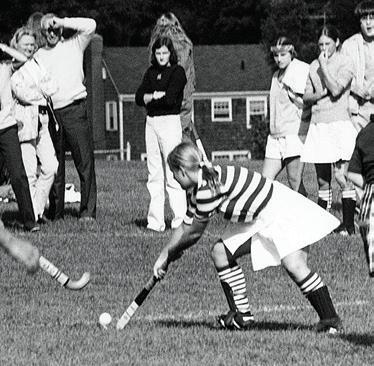
OTHER DEPARTMENTS 3 On Main Hall 5 Community Corner INSIDE FALL 2022
26
44
6
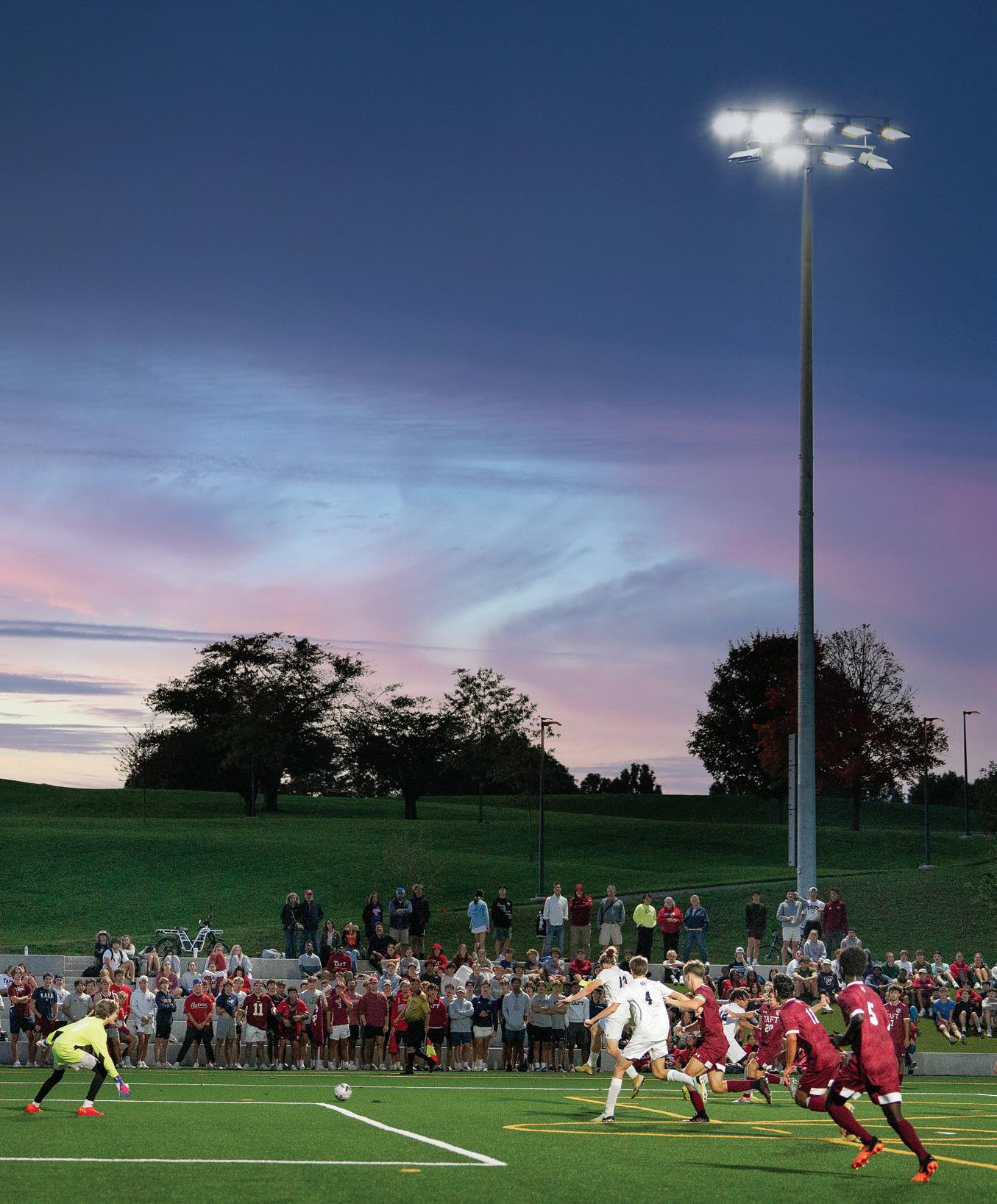
Over the summer the new turf field got one last finishing touch—LIGHTS! THANKS TO GENEROUS DONATIONS FROM A GROUP OF ALUMNI AND PARENTS, THE LOWER SOCCER FIELD WAS REBUILT IN THE PAST YEAR, REPLACING THE GRASS FIELD (WHICH HAD SIGNIFICANT DRAINAGE PROBLEMS THAT FREQUENTLY MADE IT UNPLAYABLE) WITH TURF. THE NEW FIELD WILL PRIMARILY BE USED BY THE BOYS’ SOCCER AND GIRLS’ LACROSSE TEAMS—OFFERING BETTER PLAYING SURFACES AND MORE EQUITY IN OUR ATHLETIC PROGRAMS ROBERT FALCETTI
DESIGN
Good Design, LLC | gooddesignusa.com
SEND
ALUMNI
NEWS TO taftbulletin@taftschool.org or write Taft Bulletin 110 Woodbury Road Watertown, CT 06795-2100
CLASS NOTES DEADLINES
Fall–May 1 Winter–September 1 Spring–December 1
COMMENTS? TELL US
We’d love to hear what you think about the stories in this Bulletin. Email beyusl@taftschool.org or write Linda Hedman Beyus, editor Taft Bulletin 110 Woodbury Road Watertown, CT 06795-2100
SEND ADDRESS CORRECTIONS
TO taftrhino@taftschool.org or write Alumni Records The Taft School 110 Woodbury Road Watertown, CT 06795-2100 860-945-7777
TAFTALUMNI.COM
ON THE COVER
The Platform Gallery, in Lions River, South Africa, owned by Molly Malloy ’05, features work from about 50 Midlands area artists. Much of the artwork in the restored 100-year-old train storage shed turned gallery is inspired by South African wildlife.

Malloy and the gallery host a big charity auction annually called Art for Conservation that raises money for African wildlife conservation, focusing on rhino, wild dog, and pangolin conservation. Read more in our Alumni Spotlight “Inspired in South Africa” on page 18. GLEN DU PREEZ
A NOTE ABOUT THE BULLETIN
Starting in 2023, the Taft Bulletin will be published three times a year, rather than quarterly. We remain committed to offering interesting stories and, of course, the popular class notes!
The Taft Bulletin (ISSN 0148-0855) is published three times a year by The Taft School, 110 Woodbury Road, Watertown, CT 06795-2100, and is distributed free of charge to alumni, parents, grandparents, and friends of the school. All right reserved.
Find a friend or past Bulletin: taftalumni.com Visit us on your phone: taftschool.org What happened at today’s game? taftsports.com Shop online: taftstore.com facebook.com/thetaftschool twitter.com/taftschool instagram.com/taftschool linkedin.com/school/the-taft-school vimeo.com/taftschool
Volume 92, Number
FALL 2022
4 EDITOR
MARKETING
COMMUNICATIONS
MARKETING AND COMMUNICATIONS
Linda Hedman Beyus DIRECTOR OF
AND
Kaitlin Thomas Orfitelli ASSISTANT DIRECTOR OF
Debra Meyers PHOTOGRAPHY Robert Falcetti COMMUNICATIONS ASSOCIATE/CLASS NOTES
Seamus F. Conway
ONLINE
TAFT
FALL 2022
for Conservation 2 Taft Bulletin / FALL 2022
Art
On MAIN HALL
A WORD FROM HEAD OF SCHOOL WILLY MACMULLEN ’78
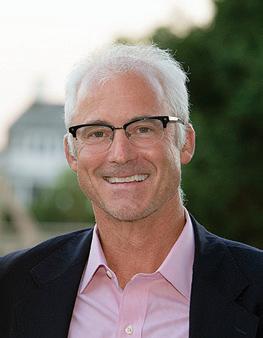
The Importance of Mission and Culture
EVERY FALL, HEAD OF SCHOOL WILLY MACMULLEN ’78 GIVES FORMAL REMARKS AT THE OPENING OF SCHOOL FACULTY MEETING. THIS YEAR MARKED HIS FINAL SUCH MEETING. “I AM THINKING OF THE WONDER OF THIS SCHOOL, AND I WILL ADMONISH US ALL TO ITS CARE,” HE SAID AS HE DELIVERED REMARKS THAT INCLUDED 10 ADMONITIONS, REMINDING THE FACULTY OF 10 FOUNDATIONAL ELEMENTS OF TAFT TO CELEBRATE AND PRESERVE. THE FOLLOWING IS EXCERPTED FROM THOSE REMARKS.
First Admonition: It Starts with Mission
I am not sure Horace Taft would have been able to answer the question “What is the mission of the Taft School?” were that posed to him when he opened the school as “Mr. Taft’s School for Boys” in 1890. After all, his CV amounted to a couple of years tutoring Latin at Yale. Like all genesis stories, ours has a bit of a mythical feel: think journey, vision, and return. Taft had fallen ill and was sent west by his doctor to visit his best friend, Sherman Thacher, in the Ojai Valley in California, where he had just opened a school. They must have talked life, education, dreams. Something happened there and soon after returning, he was talking with a family friend, Mary G.W. Black—she’s the woman whose magnificent portrait hangs in the Choral Room—who generously leased him the modest, red clapboarded house in Pelham Manor. That September evening, he offered grace at our first sit-down dinner with 14 students.
He did not use the word “mission,” but when you read his letters and writings, you can almost see the purpose of the school emerge, like a photograph washed in its tray.
Looking back on that first crazy year, he wrote: “I suppose nothing pleased me so much in my plan for a boys’ school as the idea that I might be a lay preacher, that association with the boys would give me opportunity for influencing their ideas and ideals…[and] I began to think that I was achieving some results that had nothing to do with the marking book or college examinations.”
It’s a lovely reflection, perhaps his first pass at voicing the why of his fledgling school, its animating purpose, its mission.
Soon he was speaking of “the education of the whole boy,” clearly trying to articulate an education that was moral, spiritual, emotional, and physical. Today, of course, we speak of the education of the whole student, which maybe is just another way of describing “influencing ideas and ideals.”
Every time the school has been accredited by the New England Association of Schools and Colleges (NEASC), the visiting team has noted the clarity of and commitment to mission as a singular and abiding strength of the school. There’s no observation more important.
3 Taft Bulletin / FALL 2022
“Taft will remain strong, relevant , and needed only as long as mission leads. How we meet the mission will perpetually change. But what our mission is—why we do what we do—must remain fixed like the compass needle, repeated constantly like mantra, and breathed as necessary as air.”
The phrase rolls like refrain off our tongue, and we speak of it continually, which means this is one of those rare cases where repeated use does not cause wear. It tells us that we know who we are, and that is a rare thing in schools.
We should nail that statement, literally and figuratively, on every door, above even the Portrait of a Graduate statement, Diversity, Equity, and Inclusion (DEI) statement, pledge of honor, and motto, and every major strategic and tactical decision should flow from it.
Taft will remain strong, relevant, and needed only as long as mission leads. How we meet the mission will perpetually change. But what our mission is—why we do what we do—must remain fixed like the compass needle, repeated constantly like mantra, and breathed as necessary as air.
Second Admonition: Culture Follows
Management consultant Peter Drucker famously said, “Culture eats strategy for breakfast,” and he was right.
You can find a hundred definitions of organizational culture. Some are deceptively simple: it’s “how we do things here,” or “it’s the feel of the place.” Others are more nuanced. Here’s a typical one (Deal and Peterson, Shaping School Culture): “Successful organizations have unwritten rules and traditions, norms and expectations that seem to permeate everything…and healthy organizational culture improves collegial collaboration, fosters change, builds commitment, and amplifies energy.” That sounds like Taft, where our values and beliefs—the stuff that binds us—trickles like water to bedrock.
Taft has a really healthy, strong culture. I’m guessing if I asked you to offer words, hands would shoot up: communal, inclusive, diverse, caring, nurturing, resilient, honest, trusting, safe, gritty, traditional, spirited, innovative, funny, demanding, loving….
Culture is transmitted in stories. I may be the most public of storytellers, but we all tell stories that are freighted with the messages of culture.
Culture is transmitted in rituals and traditions: last night’s dinner, this opening faculty meeting, grace and sit-down dinner, School Meeting, Alumni Parades, Hotchkiss Day, Lincoln’s nose, faculty Rookie of the Year, pledging your honor, Formal Dance, and so on.
Culture is transmitted in ceremonies: Convocation, Lessons and Carols, Service of Remembrance, Commencement.
Culture is transmitted in repeated words and phrases: Non ut Sibi, belonging, be nice, I pledge my honor, community, family, service, respect, thank you, resilience, love.
Culture is like a family heirloom you pass on, and it is at once fragile and sturdy. It requires the most caring and constant of hands, and each of you must handle it with the greatest sense of obligation, and bequeath it to those who follow you.
William R. MacMullen ’78
4 Taft Bulletin / FALL 2022
“Culture is like a family heirloom you pass on, and it is at once fragile and sturdy. It requires the most caring and constant of hands, and each of you must handle it with the greatest sense of obligation, and bequeath it to those who follow you.”
FROM THE Head of School
Vision for Taft
THE FOLLOWING IS EXCERPTED FROM REMARKS BY THOMAS ALLEN, DEAN OF COMMUNITY, JUSTICE, AND BELONGING, TO TAFT FACULTY DURING OPENING FACULTY MEETINGS.
Last year, I spoke to the community and said, “The Office of Community, Justice, and Belonging is the largest office on campus with over 600 students and 200 faculty and staff.” Today, I share that we are intentionally creating opportunities to celebrate one another. Whether it is through classroom opportunities, our celebration calendar, or affinity/alliance sponsored activities, we will celebrate in ways we have not done previously. Taft is committing itself to the work of putting the work into practice. We are not being performative so things look nice for alumni or because we want to feel better about ourselves. Rather, we are doing this because it’s what needs to be done.
This year, our goal is simple: Celebrate. Celebrate one another. Celebrate our uniqueness. Celebrate our differences. Celebrate our community. To that end, this space is going to work collaboratively with faculty, staff, and students to create those opportunities.
However, let me be clear, even in the midst of celebrating there is work that we need to continue to do. Privilege and microaggressions continue to exist in our community. Racism, sexism, homophobia, and other forms of discrimination still exist on this campus, sometimes overtly. That type of behavior reinforces this reality: we as a community have more work that needs to be done.
We must have the courage to stand up for what is right, regardless of setting, role, or any other identifier. Whether it’s from students or colleagues, the culture we are creating demands accountability.
You expect that in the classroom or the field or the stage or the dorm, but we also need to demand it from one another.
The Office of Community, Justice, and Belonging’s call to action for this year is twofold:
First: Celebrate. We are working to create opportunities to celebrate one another across multiple settings. Be proud of who you are and how you identify. Don’t be ashamed of it. Don’t hide it. Embrace it. Allow yourself to be vulnerable and let the community embrace you.
Second: Model what being an ally truly looks like for our students. Have the courage to engage in difficult conversations. Stop class, pause practice, call a dorm meeting… address the issue head on. There can be no growth without discomfort. You will have support. You’re not alone.
I look forward to this school year and joining everyone in their celebrations!”
COMMUNITY
ILLUSTRATION BY FRANZI/SHUTTERSTOCK.COM
Diversity, Equity, and Inclusion at Taft
CORNER
j 1. Celebrate 2. Model what being an ally truly looks like for our students. 5 Taft Bulletin / FALL 2022
Where Hip-Hop and Art History Collide
WHEN ELSPETH MICHAELS ’05 submitted her newsletter proposal for the inaugural Joel Gay Creative Fellowship, the odds were stacked against her. The fellowship, which was founded by New York Times bestselling author Roxane Gay and supports emerging writers, was offered to just three appli cants selected from a pool of over 1,500.
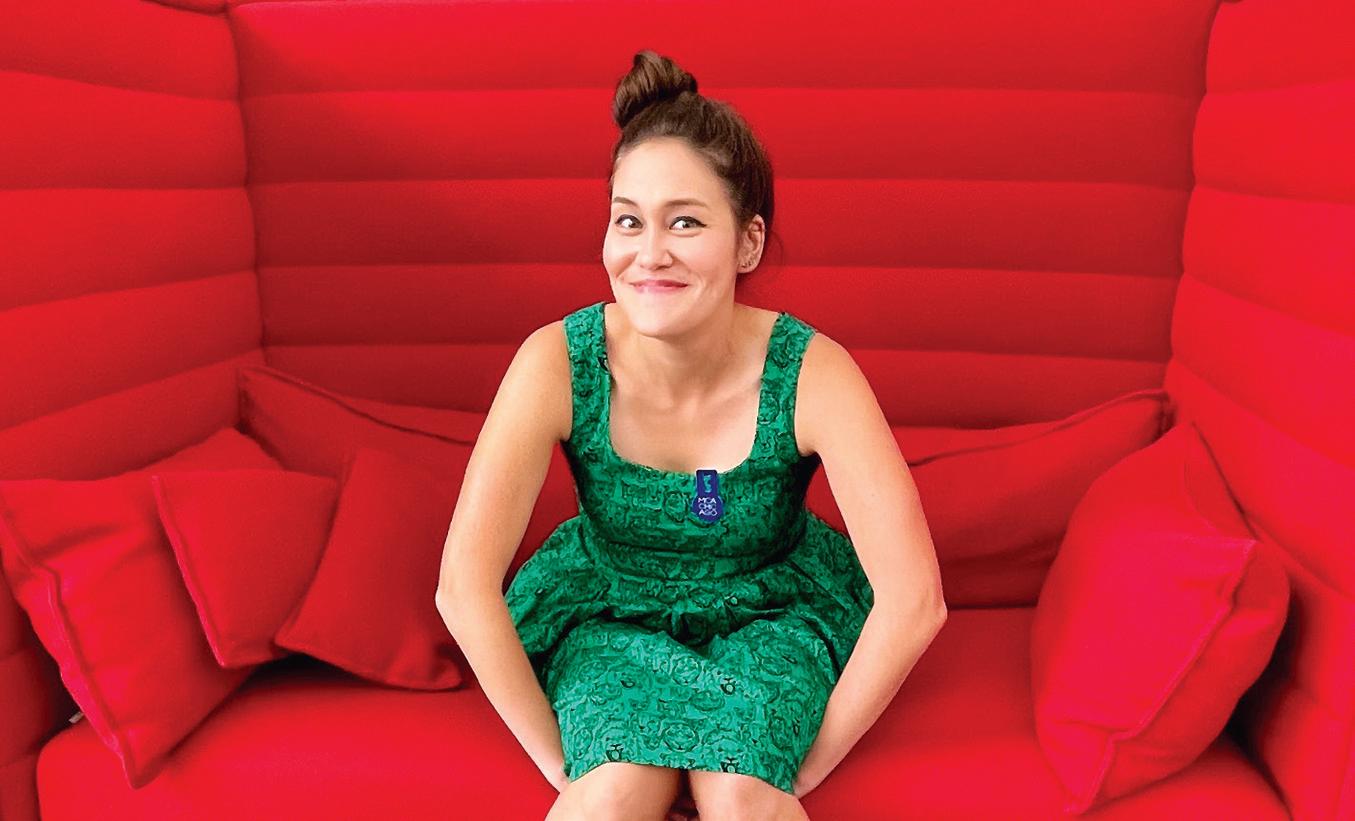
Impressively, Michaels was one of those three, and she’s since gone on to launch
The Drip, a weekly newsletter on the Substack platform that explores the inter section between art history and hip-hop.
“[The Drip] is where the mixtape meets the sketchbook,” Michaels explains.
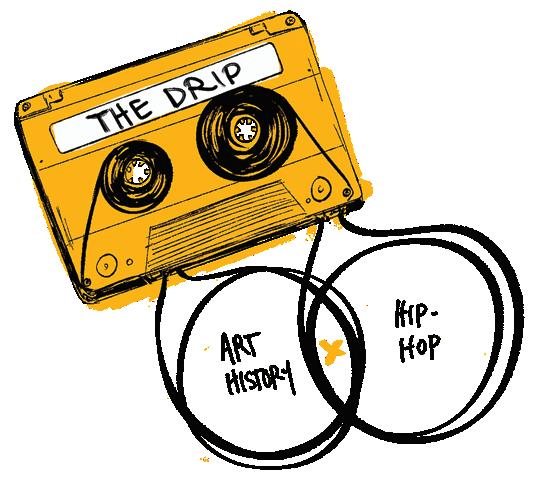
“Each month, I take a concept and break it down through weekly essays. My goal is to create an accessible space for art history and hip-hop to collide.”
Michaels says the idea started percolating
during college at the University of Chicago, where she was an art history and visual arts major. “One day in my photography class, my professor said, ‘Art history is one big inside joke.’ To exist in the canon, he
Illustration:
Top: Graphic designer Elspeth Michaels ’05 at Chicago’s Museum of Contemporary Art. KELIN HALL ’05
6 Taft Bulletin / FALL 2022
Michaels’ logo for her newsletter, The Drip. KIT MILLS
Alumni SPOTLIGHT
implied, artists make their place by study ing and referring to the greats. Something clicked for me at that moment. The more I learned about art, the more I started making these deeper connections.”
At the time, Michaels was listen ing to Kanye West, Common, and Lupe Fiasco as they came into fame and col laborated on albums that told stories about Chicago’s South Side. Her understand ing of lyrical connection to place, culture, and memory gelled in new ways as she was also honing a more academic frame work through which to analyze art.
“Both hip-hop and art history share a selfreferential practice,” she notes. “The more you listen and look, the more you start connecting samples and styles, bars and brushstrokes.”
Reflecting on her youth, Michaels says that she would listen to music while draw ing, and has always been inspired by the ways the two connect. Her passion for art really flourished while taking classes at Taft.
“Some of my fondest memories from
Taft were listening to albums in the art studio while painting with friends and singing in Hydrox,” she recalls. “I thought about this connection [between music and art] for over a decade and knew I wanted to do a project about it, but I wasn’t sure what form it would take.”
Michaels’ career path—and her journey to creating The Drip—was anything but linear. After college, she moved to Japan where she taught English for two years.
“I knew I wanted to pursue a career in the arts,” she says. “But I also wanted to travel and experience my own culture as an adult, having moved to the U.S. when I was three. [Going back and] teaching in Japan was an incredibly meaningful experience for me.”
When Michaels returned to the States, she freelanced in San Francisco before completing a certificate program in graphic design at UC Berkeley Extension. She then moved to New York, where she enrolled in a user experience design program at the Pratt Institute and fully committed
to a career in both design and writing.

In 2020, Michaels received the exciting opportunity to return to Taft to teach part time. “I’d been so focused on becoming a designer, and this brought me back to my love of art and back to the classroom, where I was mentored by my former teachers Loueta Chickadaunce, Bruce Fifer, and Steve Palmer.”
For Michaels, teaching at Taft was the initial catalyst for The Drip.
“I missed the creative process of building a curriculum and sharing ideas within the community of a classroom,” she says. “So I decided to write a newsletter, replicating the process of research, building off concepts, and distilling them into mini-lessons.”
In December 2021, she launched a pro totype of The Drip. In February, a friend forwarded her Roxane Gay’s call for submis sions, and she applied for the fellowship on a whim. A month later, she received the incredible news that she’d won.
“I fully expected a rejection or no response at all,” Michaels admits. “It’s been almost six months now, and I still can’t believe it.”
Michaels, who also works as a graphic/ UX designer at Mass. General Hospital, hopes that The Drip will be a launchpad for a book about how different art forms inter connect. Clearly, she’s onto something. j

7 Taft Bulletin / FALL 2022 Alumni SPOTLIGHT
—Carola Lovering Crane ’07
To subscribe to Elspeth Michaels’ newsletter visit thedrip.substack.com. Left: Michaels’ spray-painting Bloom Wall in Taft’s Potter Gallery for the fall 2021 show How Did We Create? AYA MICHAELS ’03 Below: content (intersections) ELSPETH MICHAELS
Both Sides of theVine
Tom Cramer '83, winery owner
TECH GURU BY DAY, vintner by night. That’s Tom Cramer’s world these days. As a vice president at Tekvisions Inc., Cramer, Class of ’83, oversees everchanging touch-screen technology used
by schools and gaming facilities. But he’s had a passion for wines since watching his father sample wines at the dinner table.
“We moved the TekVisions office to Phoenix in 1994, but then I realized
Phoenix is just way too ahead in experi encing global warming and moved the office and family to Temecula [California] wine country in 2000,” he says.
“After my kids [Abby and Jake] graduated
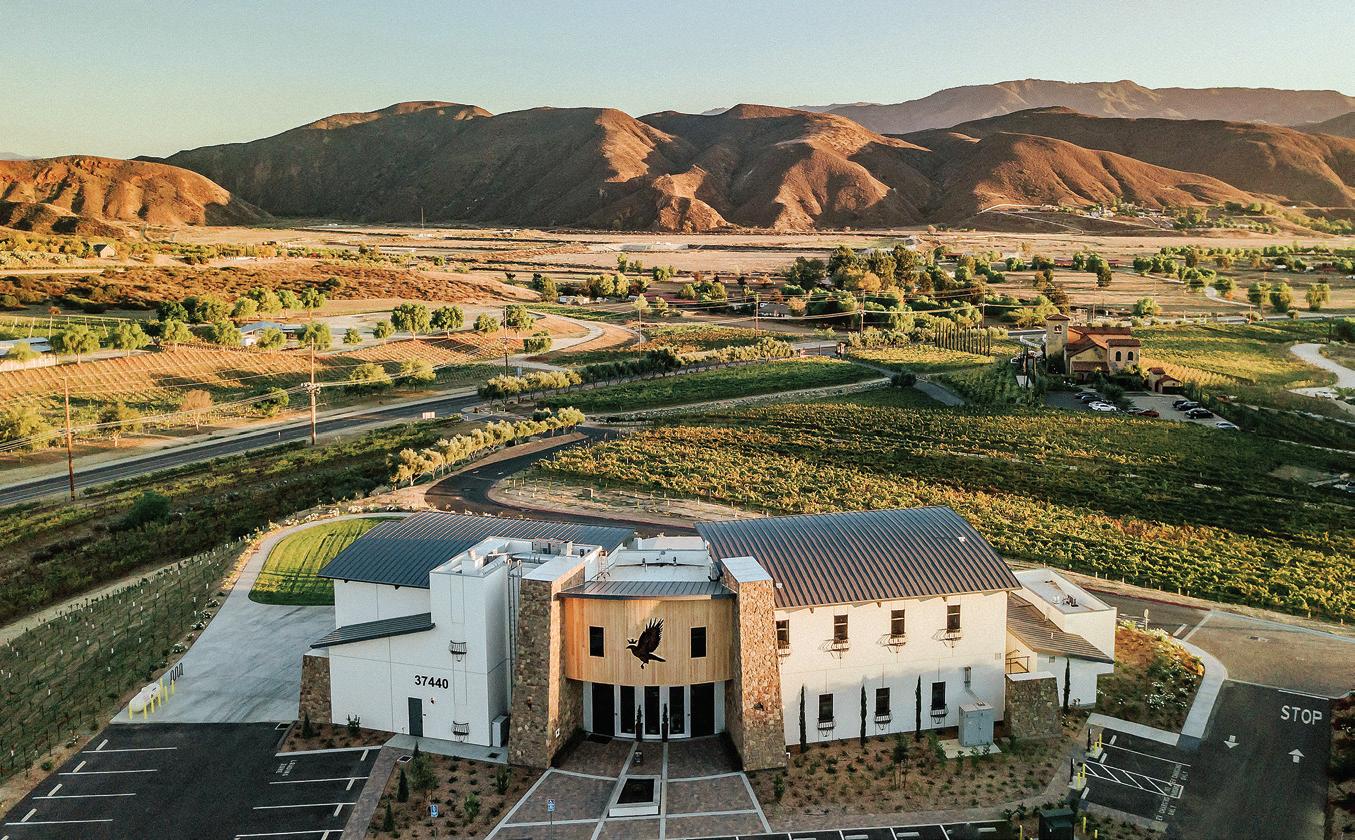
8 Taft Bulletin / FALL 2022 Alumni SPOTLIGHT
Above:
Right:
and I was single, I decided it was time for change. I moved to Laguna Beach while still working my core business. I wanted to follow a passion that had been with me since I was young—my father always had wine at the table and made it an event. His love of wine must be genetic.”

When he was approached by one of his tennis-playing friends who had pur chased land to start a winery, Cramer helped provide capital to get the fledgling winery, Altisima, underway. The winery’s name is a nod to the soaring views from the plateau on which the winery sits.

“This dream was eventually shared by eight partners. We shared the startup cost as ‘passive’ investors while the
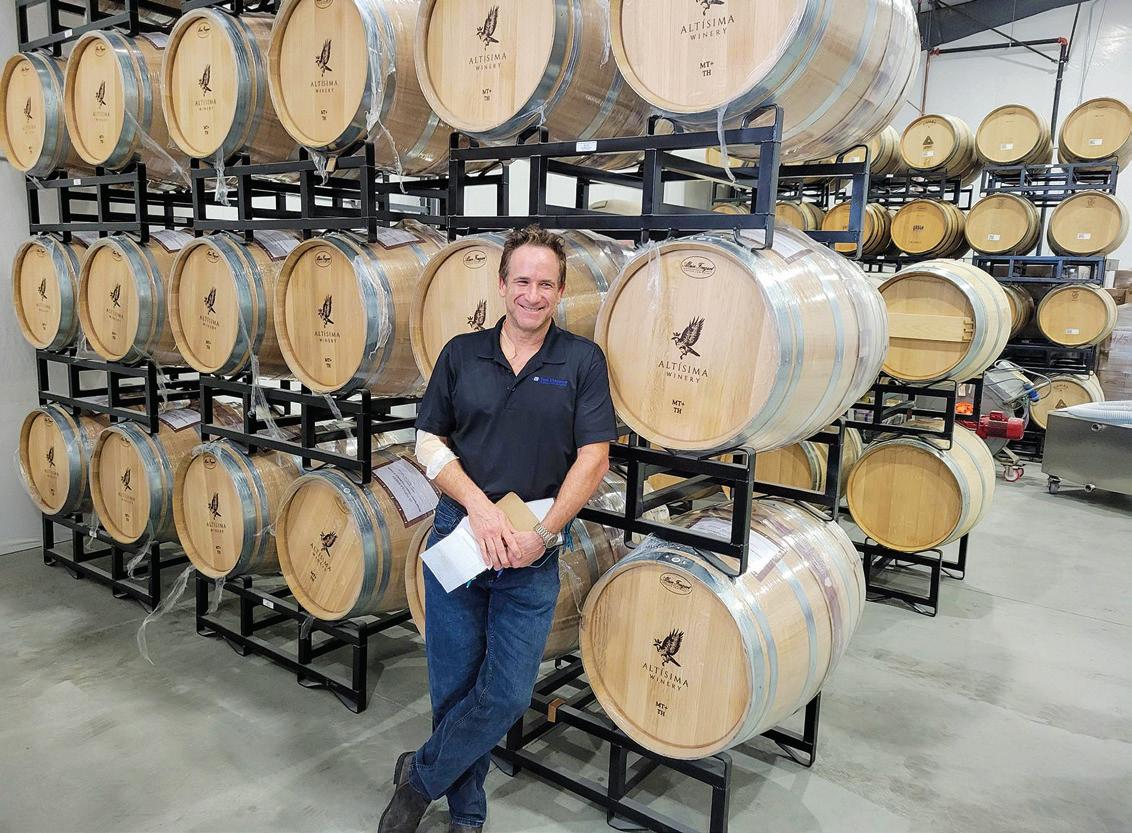 Left: Altisima Winery sits in one of California’s oldest wine regions, the Temecula Valley.
Tom Cramer ’83 at Altisima Winery, which he co-owns and opened in fall 2021.
An array of wines in Altisima's tasting room.
Left: Altisima Winery sits in one of California’s oldest wine regions, the Temecula Valley.
Tom Cramer ’83 at Altisima Winery, which he co-owns and opened in fall 2021.
An array of wines in Altisima's tasting room.
VINE ILLUSTRATION: SABELSKAYA/SHUTTERSTOCK.COM 9 Taft Bulletin / FALL 2022
“From region to weather to different varietals and to the blending of wines, I’ve always enjoyed both the science and the art of winemaking.”
Below: Cramer with his son, Jake, at the winery.

one ‘expert’ got the winery up and run ning,” Cramer says. “Lo and behold, he was no expert, and within two years, he was gone, and the eight partners had a project that was 50 percent done and in need of money. We had to learn quickly.”
Fortunately, Cramer says the eight partners ran successful businesses in construction, banking, technology, manu facturing, and hospitality, and they drew on their individual expertise to finish the project. The eight families are repre sented in the winery’s logo, a red hawk wearing a crown with eight spikes.
“We had the pieces, and where we lacked, we hired experts, including a topnotch winemaker,” he says. “Fast forward two years later, through COVID, and only a semi-ridiculous amount over bud get, we opened the doors to Altisima in November 2021 with four years of wine in inventory. As of July 2022, we have over 2,400 wine club members, a thriving
restaurant, and are profitable. We have live music three days a week, and our restaurant holds up to 180 people.”
The winery, located in Temecula County, sits in one of California’s oldest winemaking regions.

“Once we opened up, we went gang busters,” Cramer says. “It’s absolutely beautiful. We have weddings in the olive grove, people eat in the restaurant. We have 14 wines, and are known for our Spanish and Italian varietals, from Tempranillo, Sangiovese, Cabernet Franc, Pinot Grigio, Mourvèdre-Grenache, and two types of Champagnes done in the French method.”
Cramer took courses to learn every thing there is to know about running a winery and is now a Level 2 WSET (Wine and Spirit Education Trust) wine expert.
“We are knowledgeable in wines, wine production, wine grapes, wine regions,” he said. “We are not somme liers who are masters of wine. WSETs
Right: The tasting room at Altisma Winery.
10 Taft Bulletin / FALL 2022 Alumni SPOTLIGHT
are usually geared toward industry.
“Besides drinking wine, I’ve enjoyed the whole process, from planting, harvest, pro ducing, and of course, winemaking. From region to weather to different varietals and to the blending of wines, I’ve always enjoyed both the science and the art of winemaking,” Cramer says. “Wine is the most complicated liquid in the world. From when do you pick the grapes to when do you open the bottle, it’s an art as much as a science.”
The wines, which are only available at the winery or through its subscrip tion club, sell in the $30 to $50 range and provide a variety of wine experiences, from sweet Muscat to spicy Sangiovese.


Coming up next: a 44-room hotel at the winery in 2025, he says. “When I moved to Temecula, it had 11 wineries in 2000. It now has over 60 wineries and is a destination area,” Cramer says. “It’s a good thing to do. It’s fun to have a pas sion project that makes people happy.” j
Learn more at altisimawinery.com.
“Wine is the most complicated liquid in the world. From when do you pick the grapes, to when do you open the bottle, it’s an art as much as a science.”
—Bonnie Blackburn-Penhollow ’84
Above: Cramer with his daughter, Abby, at a balloon and wine festival.
Left: The vista from the patio at Altisima Winery.
11 Taft Bulletin / FALL 2022
Both Sides of the
Vine
Scott Reiner ’90, wine consultant
IT MAY HAVE BEEN A ROUNDABOUT route, but Scott Reiner ’90 is now in his dream profession: buying wines for highflying clients, including athletes, celebrities, and even Taft alumni and employees. His company, Eat, Drink and Be Happy, sources specialty wines from around the world, which means Reiner travels much of the time, discovering new wines and matching those with the right client.
“Every individual client is different,” he says. “You have to become very nimble… trying to read the customer to find what’s right for them. The sourcing of the mate rial is the most fun part. You get to travel around the world” seeking out new wines.
“I worked in finance for five years, then followed my dream to work in wine. I was confident that I knew a lot about wine at this time, a notion of which I was quickly disabused,” he says. “Initially I imported and distributed wine in New York. I learned a lot about the business, and even more about wine, but wanted a new challenge. Next, I opened a wine store in the East Village in New York City with fellow Taftie Bill McCarter ’67 in 2004. Retail was a grueling but fantastic experience. Long hours, but I learned so much about human nature, sales, business, city government, and yes, wine. I also had a blast.”
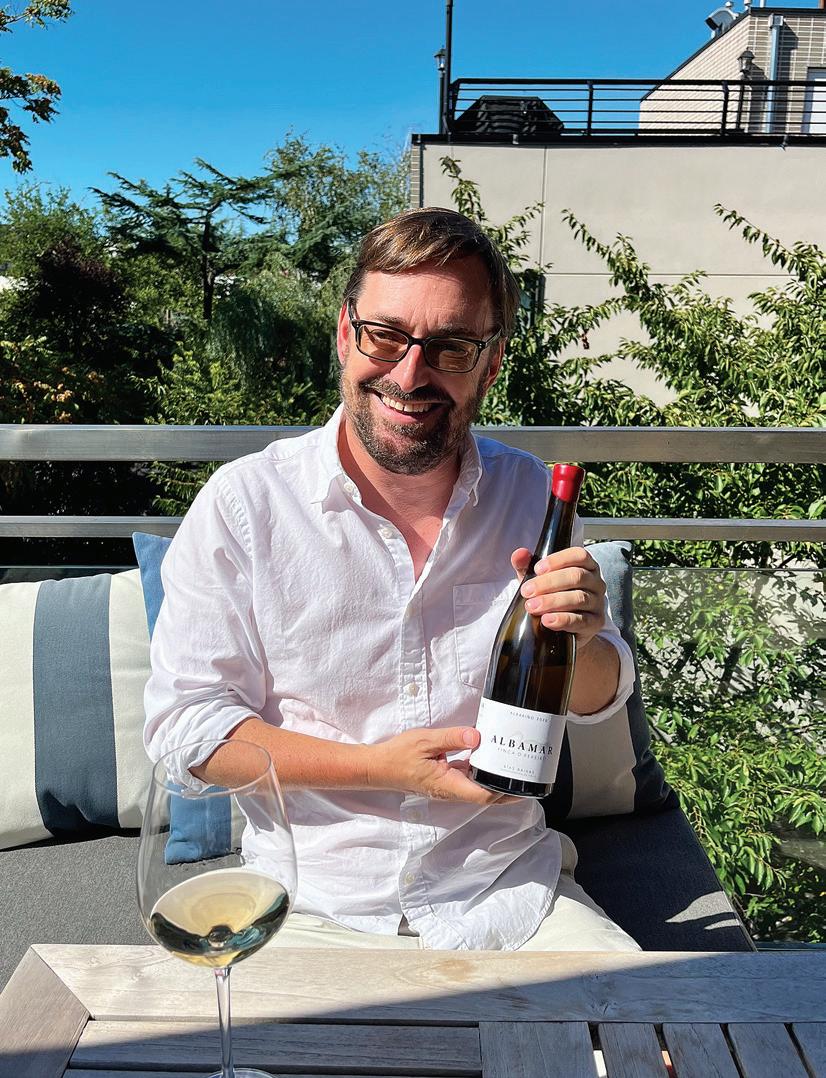
After six years, however, Reiner was ready for a new challenge.
“I then started consulting for other retail stores, helping people open new
his
Left: Wine consultant Scott Reiner ’90 enjoying one of
selections.
Alumni SPOTLIGHT
stores, and helping people who were unaware of small production wines learn how to buy the good juice. After about seven years of this I opened up my present com pany, Eat Drink and be Happy. I buy wine for individuals, initially professional foot ball players, but eventually really anyone, including a number of Tafties and members of the Taft faculty and administration.
“Since I’m not working in the confines of a retail space…I really have a much big ger product base from which to deal. The nice thing about what I’m doing now, compared to retail, is retail is tied to a physical location. Now, the way I do it, is I can do the work from anywhere.”
Sourcing new wines and matching them to the right buyer is a challenge Reiner enjoys.
“You really have to read the person and… hope you’ve done enough sourcing. You want the right wine for the right person. It’s fun just to introduce people to new wines that they didn’t know existed. I deal with smaller, handmade stuff. I provide wines no one knows about to the people who will enjoy it. It’s an interesting chal lenge and very satisfying when it works.
“There’s always cool stuff coming up. For years, Argentina and Chile were making
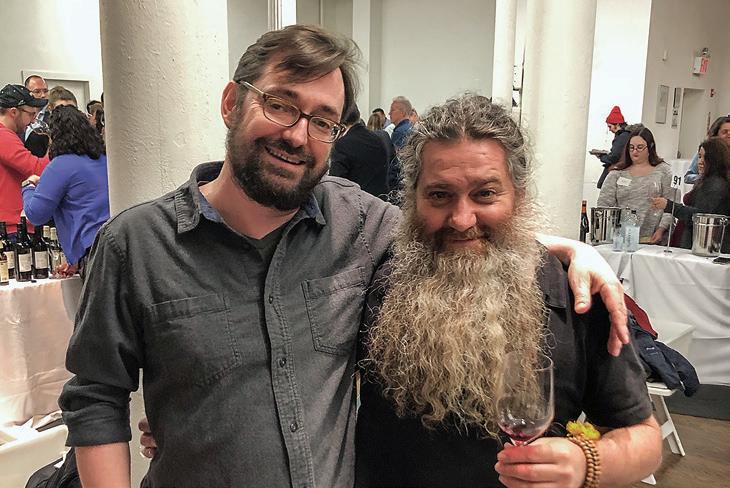
boring wines, and now they’re really cool,” he says. “As the space for vineyards dries up, people have to find less expensive land. You have young people with new ideas and dif ferent ideas. They buy land inexpensively, and 10 years later they’ve got great wine.”
By traveling the globe, Reiner is able to sample up-and-coming regions and wines and discover the next new trends.
“As established regions become more expensive, every generation has to find a
new, cheaper way to do things, especially now that you can buy good wines every where all over the world,” he says. “It never ends: every year you have a new vintage, with new weather patterns, new wines. Some success stories and some failures.”
Understanding the client’s palate is also key. Reiner initially met his clients through his contacts in the financial world and then grew his business through word of mouth. Reiner has a conversa
Left:
tion with new clients about their likes and expectations, followed by a few cases of carefully-chosen ‘test’ wines to really hone in on what the client is going to enjoy.
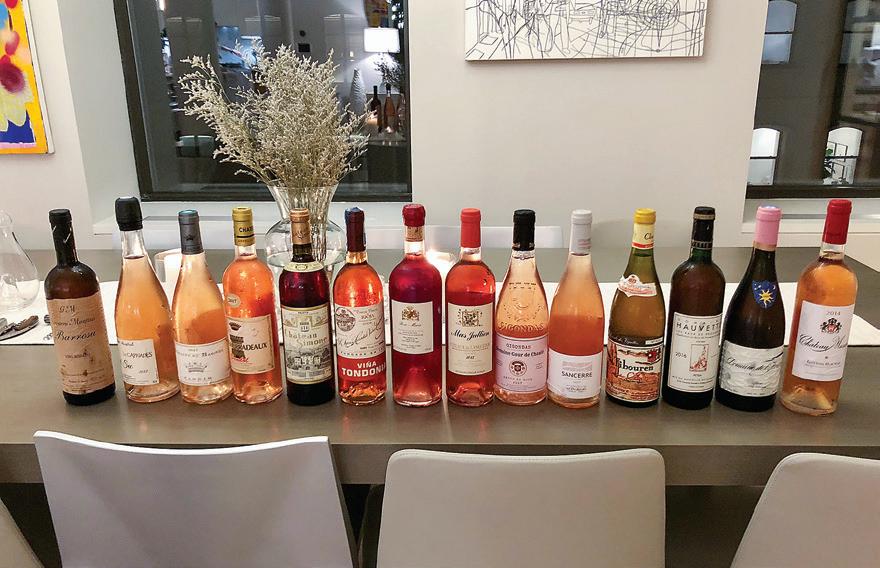
“The idea is to find what the person wants” in a wine, Reiner says. “Everyone likes something different, but doesn’t have the time or experience to find what they are looking for. That’s my job! j
—Bonnie Blackburn-Penhollow ’84
To contact Scott Reiner, email scottreiner@gmail.com or visit eatdrinkandbehappy.net.
Above: Reiner at a tasting with Raul Perez, “arguably the best winemaker in Spain,” Reiner says.
13 Taft Bulletin / FALL 2022 Alumni SPOTLIGHT
A carefully selected array of rosés curated by Reiner for an event.
Going With the Flow
“THIS HAS BEEN A WONDERFUL FIELD to work in because everyone can get behind drinking water, no matter where you live or your political background. We all need it, and it’s incredibly important that we protect it,” says Jennifer O’Hara Palmiotto ’82, who recently became senior federal policy advisor for the National Rural Water Association. In this role, she acts as a voice for the thousands of small water systems that provide clean drinking water and safe wastewater treatment for the United States’ most remote communities.
“The utilities in the big cities usu ally have the resources and the time to send someone to national meetings and implement new ideas, but the little sys tems often only have one or two people running their operations, so it’s just not practical for them,” Palmiotto says. “I’m able to represent their interests, to inter ject a perspective that isn’t normally at the table.” And considering that the U.S. comprises more than 52,000 community water systems—91 percent of which serve fewer than 10,000 people, with more than half serving just 25 to 500 people—she certainly has her work cut out for her.
Palmiotto was somewhat of an early disciple of the environmental movement, coming of age at a time when concerns about pollution and the changing climate were only just gaining widespread atten tion. But thanks to one inspiring professor while an undergraduate at the University
of Vermont, she quickly developed a pas sion for conservation—first working with researchers studying palm species in Belize and then earning a Ph.D. from the Yale School of the Environment and briefly teaching at Bowdoin and Bates colleges.

After a few years, though, Palmiotto reached a watershed moment in her career, realizing that she could make a greater impact outside of academia. So, she rolled
up her sleeves and became a source water specialist in the Northeast, traveling throughout Vermont, Massachusetts, and New Hampshire to consult with rural communities, identify potential sources of contamination in their drinking water supplies, and develop customized solu tions—which included everything from measuring chemical levels in the water and helping local stakeholders apply for
~ ~
14 Taft Bulletin / FALL 2022 Alumni SPOTLIGHT
Jennifer O’Hara Palmiotto ’82, senior federal policy advisor for the National Rural Water Association, rowing in the Adirondacks, where she recreates and also finds inspiration for her paintings.
~
federal grants to setting up fake coyotes to deter ducks and geese from landing on the surface of reservoirs. “By that point, I had worked in a number of different areas, but I was always coming back to water,” she says. “And this job drew on a bunch of skills that I had, like working with people, land conservation, and edu cation. It really tied up a lot of loose threads and said to me very clearly that this was where I should be.”
Palmiotto followed her time as a source water specialist with a 14-year tenure as the executive direc tor of Granite State Rural Water Association, which caters to all of New Hampshire’s water and wastewater systems, before expanding her reach and joining NRWA in March 2021.


“As a rural person myself, I really understand the struggles of small systems—from cybersecurity and operational concerns to regulatory issues and all of the chemicals they have to monitor,” she says. “Previously, the NRWA didn’t have the bandwidth to

send someone to represent these smaller systems at conferences and important meetings, but by bringing me on board, we are able help them have a presence in conversations with the Environmental Protection Agency and other organiza tions working on water resource issues.”
While her new role requires that she crisscross the country—in the past few months alone she’s attended major con ferences in Florida, Ohio, Wisconsin, and Maryland—Palmiotto never loses sight of the needs of the people she rep resents. “The small systems I work with are the ultimate natural resource manag ers, and they are seeing firsthand the effects of increasingly severe storms, droughts, and wildfires,” she says.
“But at the same time, the field staff of the NRWA do so much incredible work on the grassroots level to help them. This model was formed 45 years ago by rural Americans to create water systems for their communities and families. The problem was identified by local people, and the solution was also identified by local people, so I’m glad to now get to be a part of that legacy and be an advocate on their behalf.” j
—Christopher Browner
’12
Above: Palmiotto with National Rural Water Association CEO Matt Holmes, during the NRWA’s annual conference.
Right: An Adirondacks-inspired watercolor, Island by Jennifer Palmiotto.
15 Taft Bulletin / FALL 2022 Alumni SPOTLIGHT
Below: Palmiotto at the U.S. Water Alliance’s One Water Summit 2022 in Milwaukee.
Eric Woolworth ’83, Miami Heat president, business operations, addresses HEAT Academy students and teachers at a yearend celebration at FTX Arena. HEAT Academy, now in its 24th year, is an afterschool program and the NBA franchise’s flagship community initiative that provides approximately 300 students in three inner-city schools with extra exposure to reading, writing, math and science. MIAMI
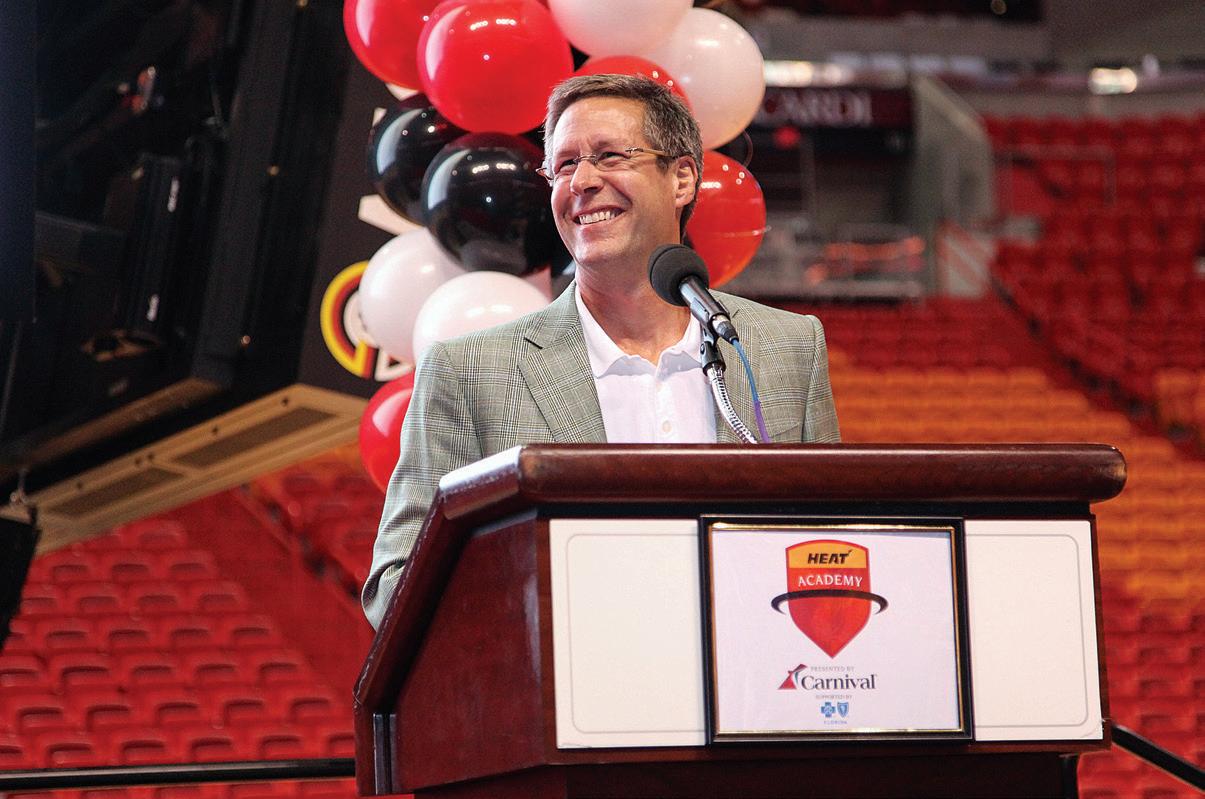 HEAT
HEAT
Leading the Miami Heat
LIKE MANY SPORTS FANS, Eric Woolworth ’83 recalls exactly where he was on the night of March 11, 2020, as the world began to realize the grav ity of the surging COVID-19 pandemic: He was in Miami, watching the Heat play the Charlotte Hornets, when phone rang. It was the league office calling.

“[Utah Jazz center] Rudy Gobert just tested positive,” he was told. “The NBA is shutting down.” Woolworth says the first words out of his mouth were, “What the hell does that mean?”
As the president of business operations for the Heat, Woolworth says he is respon sible for “all the outward-facing elements of running a sports and entertainment operation,” which includes booking nonbasketball events for Miami’s FTX Arena. Instantaneously, in-person events went from desirable to impossible. He was in command of a 20,000-seat ghost town.
Woolworth called a meeting with staff the next day and said, “I’ll see you in a couple of weeks.”
“Obviously,” Woolworth says, “that dragged on, and on, and on.”
The NBA returned later in the summer, but only in a virtual “bubble” environ ment in Orlando. It would be nearly a full year before the Heat would welcome basketball fans back into its arena.
In the intervening months, Woolworth says, his mindset remained focused on the day that live events would return, and he made sure his staff maintained their regular meetings over Zoom.
“A lot of people in the industry, once it became clear it was going to be a longerterm issue, they laid off staff or had people take pay cuts,” Woolworth says. “We remained confident that eventu ally we were going to come back. And the organizations that were going to do
well were the ones that were ready.”
Last April, the NBA recognized the Heat with the league’s sales and marketing “Team of the Year” award, which covered its business performance over the previous 24 months. Woolworth accepted the award from NBA commissioner Adam Silver.
“He said to me, ‘Congratulations, you won the pandemic,’” Woolworth says.
Miami has gotten used to winning. It might surprise some people to learn that the Heat owns the NBA’s second-longest active sellout streak, with a capacity crowd at every home game since 2010. That record has remained intact even after the departures of superstars LeBron James, who played for the Heat from 2010 to 2014, and Dwayne Wade, who retired in 2019.
“When I got to Miami, every one I met said, ‘It’s a football town,’” Woolworth says. “Now, we sell T-shirts that say, ‘Basketball Town.’”
16 Taft Bulletin / FALL 2022
In addition to three NBA champion ships in 2006, 2012, and 2013, the Heat won the league’s inaugural Inclusion Leadership Award in 2018, given to the organization with the strongest record and commitment to diversity and inclusion. At the time, the Heat’s full-time workforce was 70 percent minority and 33 percent women.


But Woolworth says the franchise’s commitment to diversity was nothing new.
“Miami is an incredibly diverse place,” he says, adding that he always felt like the organization should reflect that. “No matter where you were from or what group you associated yourself with, when you came to the arena, you would find somebody that was like you.”
Woolworth wasn’t always a hoops fanatic. A tri-sport varsity athlete at Taft, lettering in soccer, hockey (cocaptain in 1982–83), and track, his parents had tick ets to the New York Giants, Yankees, and
Corp., the cruise line, and he desperately wanted Woolworth to move to Miami. Woolworth resisted, saying Florida was “just for old folks,” and the only thing that might change his mind was if he could work in professional sports.
Two months later, Carnival’s chief executive, Micky Arison, assumed major ity control of the Miami Heat in 1995, and Woolworth, then 30, became one of his first hires, as the team’s general counsel.
Arison simultaneously brought in a slightly more credentialed name to handle the basketball side: Pat Riley, the champi onship-winning former coach of the Los Angeles Lakers and New York Knicks.
Rangers games—but neglected the Knicks.
Attending Georgetown University during the Patrick Ewing heyday of the mid-’80s changed his opinion of the sport. But Woolworth planned to pur sue a career in environmental law after finishing Georgetown Law School.

His father-in-law was at the time the chief operating officer of Carnival
Riley and Woolworth have now worked side by side for 28 years. Not bad for a guy who says he could never really dribble with his left hand.
“It’s been an incredible ride,” Woolworth says, “to get in on the ground floor and be part of the growth of one of the premier sports leagues on the planet has been incredible.” j
Above: Woolworth with the Miami Heat’s three Larry O’Brien Championship trophies, earned in 2006, 2012, and 2013 MIAMI HEAT
Left: During the Heat’s annual Veterans Day Renovation project—one of several community efforts the team hosts—Woolworth helped repaint the home of a retired vet. MIAMI HEAT
Below: Woolworth addresses Miami Heat season ticket members during a town hall event at FTX Arena. MIAMI HEAT
’05 Alumni SPOTLIGHT
—Zach Schonbrun
Inspired in South Africa
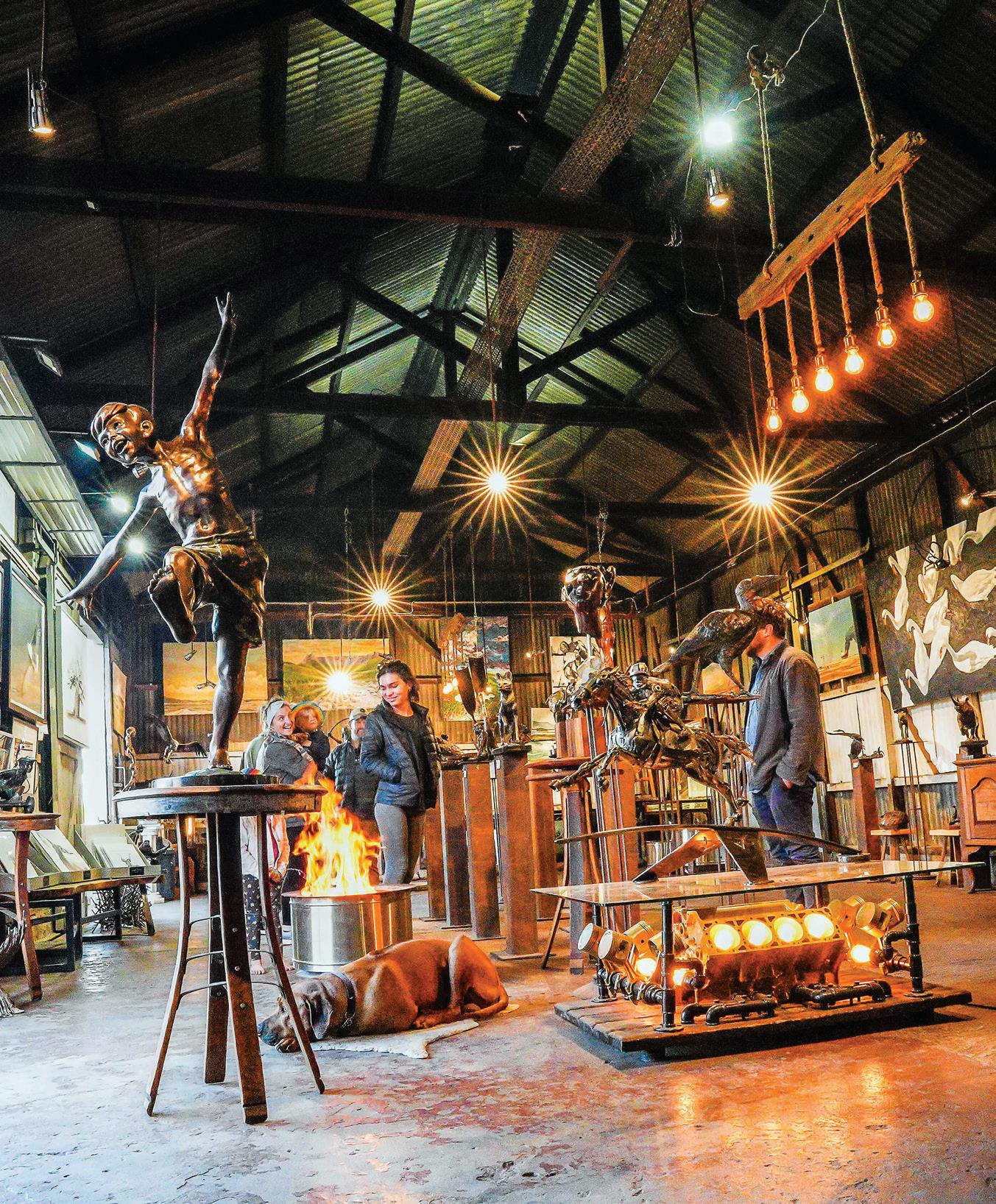
DRIVE THROUGH THE SMALL TOWN of Lions River, in the bucolic Midlands of South Africa, and you’ll pass a cluster of quirky buildings beside a railway line.

There’s a large, former railway stor age shed that’s been converted into an art gallery. There’s a double-decker bus that’s been converted into a cafe, and a series of storage containers that have been con verted into hide and leather goods stores.
The compound and all the businesses in it are run by Molly Malloy ’06 and her husband, Glen du Preez. And that’s just the start of the couple’s business ventures: they also run a small game lodge and sell
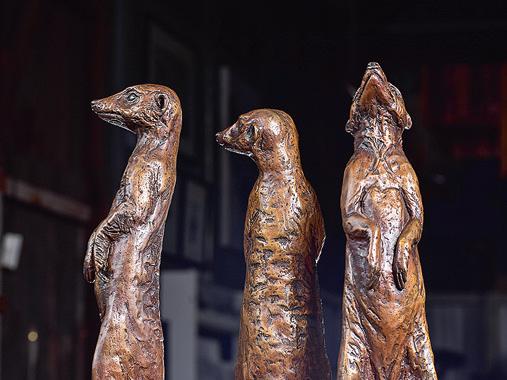
smokeless fire pits that du Preez invented.
At some point, the entrepreneurial cou ple might scale back. But for the moment, Malloy says, “we’re still in the ‘more’ phase.”
Malloy grew up half a world away, in Stamford, Connecticut. As an economics major at Amherst College, she was convinced she was headed for a career in finance.

Her finance career lasted just two years, however. Eager to travel, she quit her New York City job and joined a pro fessional sailing crew. “If I’m completely honest, I thought I’d do it for maybe six months,” Malloy says of sailing.
She loved the work so much that six
Above: Neighborhood Sentries by Sarah Richards.
Opposite: Inside the Platform Gallery, which features work by local artists in the Midlands area of South Africa.
Left: Molly Malloy ’06, owner of the Platform Gallery in Lions River, South Africa.
19 Taft Bulletin / FALL 2022 Alumni SPOTLIGHT
Below: The Platform Gallery is located in a restored 100-year-old train storage shed.
Opposite page top: Inside the Platform Gallery.
Opposite
months turned into four years. Yacht racing and transporting sailboats from one mooring to another took Malloy from New England to Costa Rica, Europe, and the Caribbean. Along the way, she met her now-husband, a South African.
On Malloy’s first trip with him to South Africa, the couple came up with their first business: partner ing with a Lesotho-based nonprofit to sell local arts and crafts.
That business didn’t last, but their second idea, selling cow hides, did. “My husband’s family has farmed Nguni cattle, for [maybe] 100 years,” Malloy says. She
and du Preez worked out of his family home. They later moved to the Midlands, a scenic area full of farms, winer ies, and wedding venues, and she and du Preez have been growing an array of small businesses ever since.
Perhaps their favorite business, Malloy says, is the Platform Gallery. Their gal lery has featured work from about 50 local artists over the past four years, and displays everything from bronze and metal sculptures to paintings, drawings, and photography. Much of the artwork is inspired by South African wildlife, and many of the buyers are either local or visi tors from South Africa’s major cities.
The space, a 100-year-old storage shed with high wooden beams, sets the tone for the display. “So many galleries these days are just pristine white walls, and you walk inside and you feel like you have to whisper, like you can’t really talk inside,” Malloy says. “We wanted to create a space that was the antithesis of that.”
Malloy has always loved art and art his tory, and enjoys both curating the gallery and helping artists find buyers. “There’s nothing better than being able to call one of our artists who’s also become a good friend and tell them that one of their pieces has sold,” she says. “It brings joy to everyone.”
Malloy and du Preez are also using the gallery to give back. Last year, they held a charity art auction, Art for Conservation, in partnership with the Boucher Legacy,

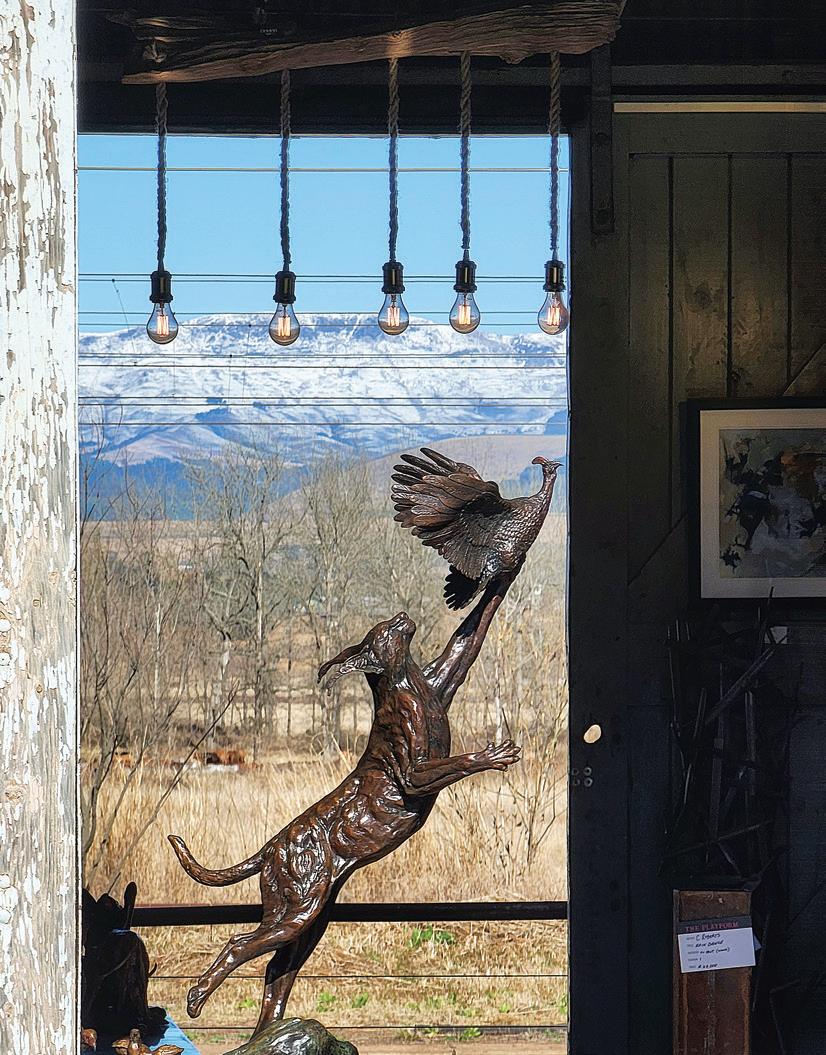 Right: Black rhino maquette by Sarah Richards.
Below: Feathers & Fur by Allen Hallett.
page bottom: Vantage by Michael Mawdsley.
Right: Black rhino maquette by Sarah Richards.
Below: Feathers & Fur by Allen Hallett.
page bottom: Vantage by Michael Mawdsley.
Alumni SPOTLIGHT
a wildlife foundation headed by former South African cricketer Mark Boucher. The foundation focuses on rhino, wild dog, and pangolin conservation.
The auction raised about $150,000, Malloy says, with part of the proceeds going to conservation. Malloy and du Preez are planning a second event in spring 2023, this time potentially involving a golf day and appearances by South African sports celebrities.

“Our hope is to try and get close to double the amount of funds raised from last year,” Malloy says, “which obviously isn’t a small thing…but we like to dream big.”
Looking back, Malloy sees a connection between her adventurous adult life and
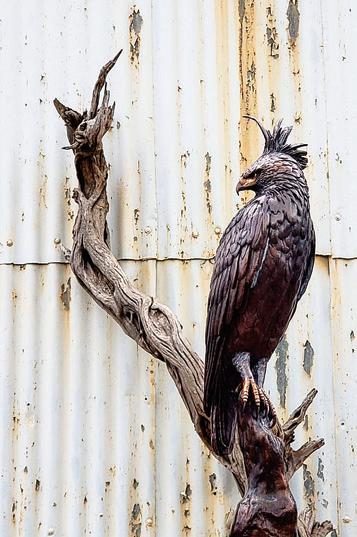
her decision, as a teenager, to switch high schools after her sophomore year to play varsity field hockey and ice hockey at Taft. That decision, she says, was “one of the most insane things I’ve done in my whole life.”
“I think going through and choos ing what, at least in my family, was a path less traveled, and leaving Stamford, where you have this huge network of support, for this little boarding school upstate—I think it’s something that encouraged me to take the path less trav eled throughout my life,” she says. j
—Sophie Quinton ’06
21 Taft Bulletin / FALL 2022
Photography by Glen du Preez
From Bogs to Bonitos
EVEN IN RETIREMENT, off days are rare for Parker Mauck ’77.
Three years ago, he cofounded a salt water fly and light tackle fishing company, Westport Fly, in Westport, Massachusetts, a small coastal town along the southern rim of Buzzard’s Bay. Sharing the captain duties with Chris Killenberg, they’re typically on
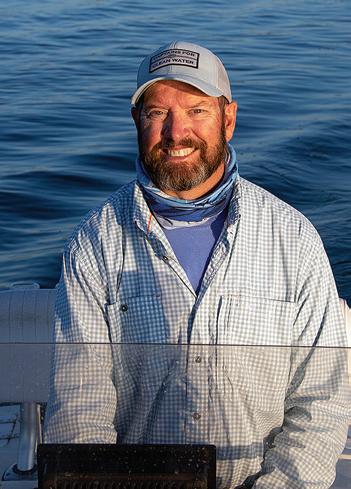
the water six days a week guiding trips any where from Little Compton, Rhode Island, to Cape Cod from March through October.
Running a fishing business is not always easy, but it’s not exactly unrewarding. On his seaworthy, 20-foot vessel—nicknamed Hat Trick, for his three boys—Mauck fol lows striped bass and bluefish all season
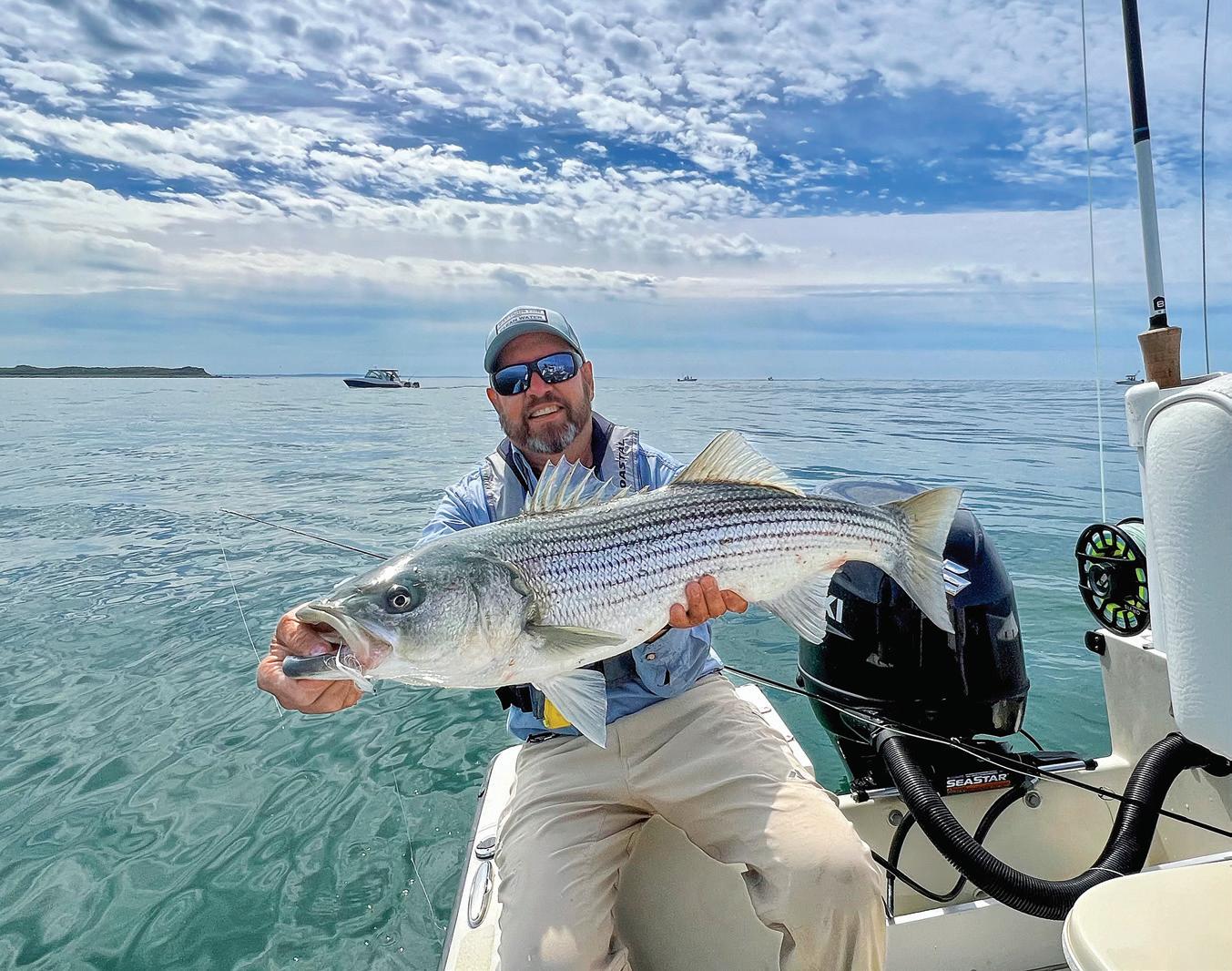
22 Taft Bulletin / FALL 2022
“Not a lot of kids that go to prep school end up milking cows.”
as they migrate up and down the New England coast. But it’s late in the summer and early fall, when the gamier “tunoid” fish start to come ashore, when Captain Mauck says things get really exciting.
“They go on these explosive runs where they scream your line away and you’re just holding on for dear life,” Mauck says of the false albacore and bonitos. “There are these 30-second moments of all this biology
Opposite page top: Parker Mauck ’77 with a striped bass from the waters off Westport, Massachusetts, home of his saltwater fly and light tackle fishing company, Westport Fly. CHRIS ROACH ’75
Opposite page bottom: Captain Mauck at the helm. ALEXANDRIA MAUCK
Below: Harvesting cranberries, an agricultural sector Mauck previously worked in for two decades.

happening—bait fish in the air, false alba core or bonitos flashing through them, birds crashing down on them. You get these brief moments of chaos. It’s really, really fun.”
You can hear in his voice that Mauck is fulfilling a childhood dream. In Katonah, New York, he “grew up as a kid walking down the trout stream with a fly rod and a box of flies,” Mauck says. “I got kind of addicted to it.”
After graduating Hobart and William Smith Colleges, he and a friend, Terry McDonnell, flew to the other side of the planet in search of better trout fish ing in New Zealand. For six months, they bummed their way across the South Island, fishing, hunting, camp ing, and earning money as farmhands.
When they returned to the U.S., Mauck knew what he wanted to do. He wanted to remain involved with agriculture and continue earning a living off the land.
“Not a lot of kids that go to prep school end up milking cows,” Mauck jokes. “But it was just something I was drawn to. I just loved it. It was hard work, but I didn’t mind it. I got up early in the morning really looking forward to what was going to happen that day.”
After several years working at dairy farms in Massachusetts and Rhode Island, Mauck became the general manager of a small agricultural cooperative assisting local farmers to get their produce onto the shelves of big grocers. It was his first taste of office life. Surprisingly, it suited him.
He soon got hired by Decas Cranberries, a seller of fresh and dried cranberries sourced from hundreds of acres of bogs in Massachusetts, Wisconsin, and Canada. From 2008 until Mauck’s retirement last May, he was the director of grower relations, working with farmers to keep tabs on their products and keep the processing plants busy.
Alumni SPOTLIGHT
Below:
Opposite
Opposite
Opposite
Growing cranberries is a tricky busi ness. For those unfamiliar with the process, it’s best to forget everything you know about traditional dirt farming.
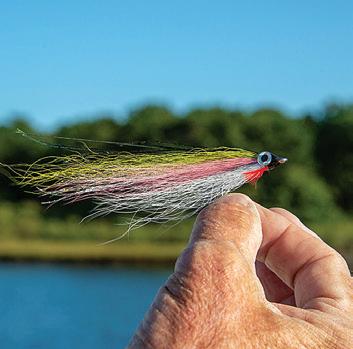
For cranberries, you start with a bog.
“You basically have to build an artificial wetland,” Mauck says. “You have to construct dikes and ditches and sand layers, under ground sprinkler systems. You have to get vines from another bog somewhere and cut them into small pieces and scatter them on top of sand and they’ll hopefully take root.”
Then, you wait.
“It takes about three to five years for those little shoots to mature to the point where they’ll start producing a commercial-sized crop,” Mauck says.

This makes commercializing cranber ries a delicate practice. As with most produce, demand for cranberries is cycli cal—it goes through hot periods and cold periods. But the cranberry lag period makes forecasting the cycles difficult even for the most confident soothsay ers. Plant too much during a hot period and you could be stuck with a surplus of berries if production exceeds demand.
 Left: Mauck choosing a saltwater fly. ALEXANDRIA MAUCK
A carefully tied saltwater fly.
page top: A client with a False Albacore also called an “Albie.” VICTORIA KAMP
page middle: Mauck with a content client holding their catch, an “Albie.”
Left: Mauck choosing a saltwater fly. ALEXANDRIA MAUCK
A carefully tied saltwater fly.
page top: A client with a False Albacore also called an “Albie.” VICTORIA KAMP
page middle: Mauck with a content client holding their catch, an “Albie.”
24 Taft Bulletin / FALL 2022 Alumni SPOTLIGHT
page bottom: Sunset fishing in Buzzard’s Bay.
“From a horticultural and farming stand point, it’s completely different from all other agriculture that you see in the Northeast,” Mauck says. “It’s very unique. The approaches you use, the strategies you use, the tools and the machinery are all very specialized.”
Mauck started Westport Fly in 2019 as he began to plot his retirement. In May, he stepped away from Decas to put on his captain’s hat full time.
In the summers, he’s guiding small groups from beginners to experienced anglers. “If they’re novice, we spend a little bit of time with some coaching and teaching about casting,” Mauck says. “Experienced anglers that have those skills, our job is to know the waters and put those anglers on fish.”
In the winter, when not tying his own flies, Mauck has planned group fishing excursions to Cuba, Florida, and southern Louisiana.
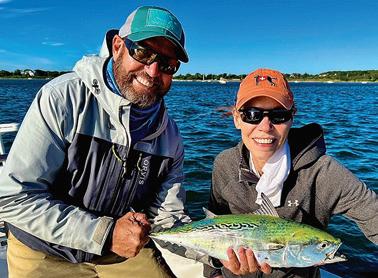

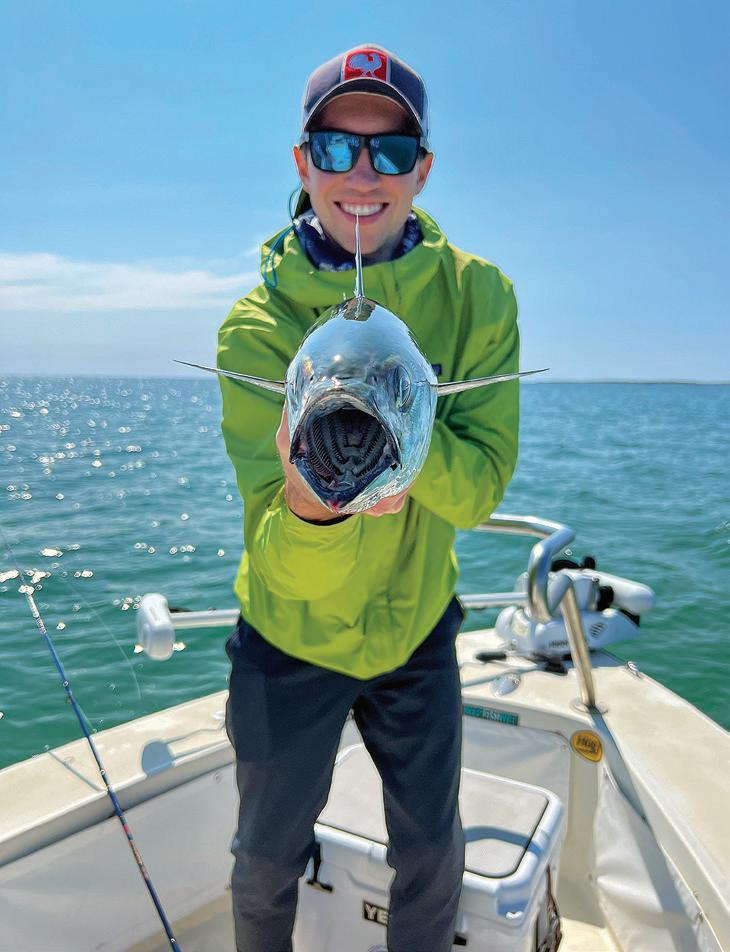
There is one thing he says he will
miss most about the cranberry busi ness: the October harvest.
“They flood the bogs and use special ized machinery to thrash the berries off the vines and the berries float,” Mauck says. “They corral the cranberries and pump them in the trucks. It’s incredible visually.”
He describes a perfect harvest day—blue skies, red cranberries, resplen dent foliage—and there’s a touch of wistfulness in his voice. It disappears quickly, however. Back to fishing.
“It’s been an amazing summer,” Mauck says. “Fishing’s been really consistent. We’ve been super busy, it’s been great.”
He sounds like a kid again. j
25 Taft Bulletin / FALL 2022 Alumni SPOTLIGHT
—Zach Schonbrun ’05
Around THE POND
BY DEBRA MEYERS
Summer Journeys
EVERY SUMMER, TAFT STUDENTS TRAVEL THE WORLD CARRYING OUT THE SCHOOL MOTTO: NON UT SIBI MINISTRETUR SED UT MINISTRET; NOT TO BE SERVED BUT TO SERVE. MANY DO SO WITH SUPPORT FROM ENDOWED FELLOWSHIPS. THIS YEAR, TAFTIES SERVED IN FASCINATING DESTINATIONS—VIETNAM, MEXICO, FIJI, POLAND, AND CUBA, TO NAME A FEW. IT IS A PRIVILEGE TO SHARE THEIR STORIES HERE.
Robert Keyes Poole ’50 Fellowship Travelers
The Robert Keyes Poole ’50 Fellowships, established in memory of Robert Keyes Poole, Taft teacher from 1956 to 1962, are awarded annually to enable Taft students to engage in travel or in projects consistent with Mr. Poole’s lifetime interest in wildlife and the environment.
Marine Conservation: A Deep Dive into the Waters of Mexico
Isabel Cheng ’23
DURING A FAMILY TRIP TO THE Arctic when she was 9 years old, Isabel Cheng ’23 met a marine biologist.
“That was my introduction to the world of marine science,” Isabel says, “and I’ve been intrigued by the ocean ever since.”
Two years later, Isabel earned her Open Water Diving certification. She continues to dive recreationally, and has gone on to earn additional diving certifications, but she was looking for something more.
Isabel found her something more in La Paz, Mexico, where she worked with marine scientists from Projects Abroad on a series of initiatives built around protecting and preserving essential coastal resources.
“Our primary job was conducting marine surveys—counting the number of certain

For more information, visit www.taftschool.org/news
species as an indicator of ocean health in the area,” Isabel says. “The objective was to monitor the health of the ocean in dif ferent areas along the coast and measure the impact of various human activities. The locations we surveyed included a dock next to a phosphorus mine and an area close to a local fishing spot.”
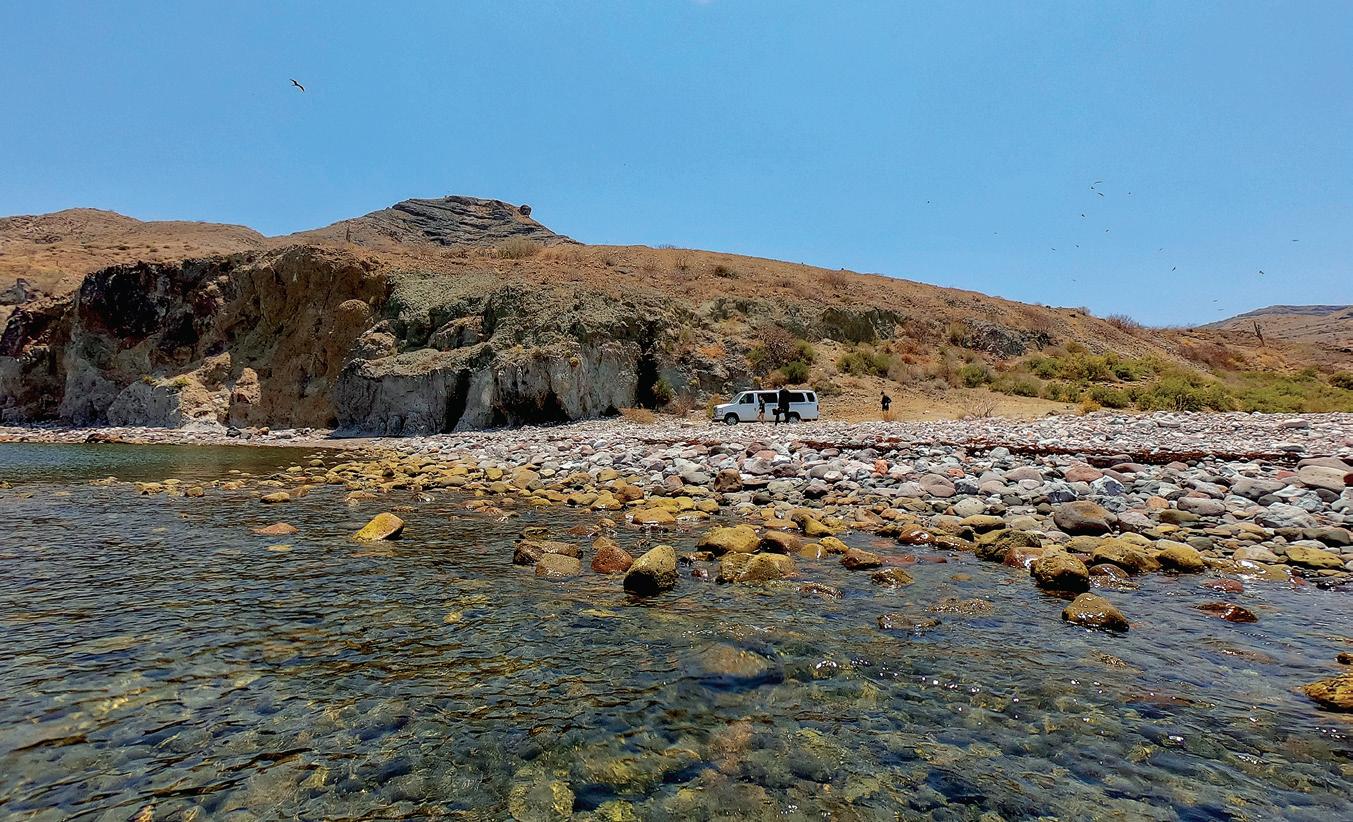
To gather survey data, Isabel and her team were required to scuba and free dive in water that was 60 degrees Fahrenheit—very cold, Isabel notes, even with the thickest 8-millimeter wetsuits.
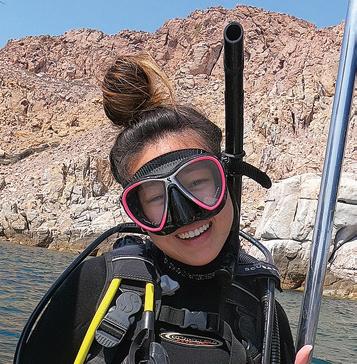
“I had the opportunity to step up as an Advanced Open Water/Rescue Diver, whether that meant checking everyone’s gear, making sure everyone was healthy and hydrated, maintaining good buoyancy underwater, or simply logging dives toward getting my Divemaster certification, the next one I’m working toward. Free diving, however, was more challenging. We had a training day where we went to a shipwreck and learned different techniques for hold ing our breath and diving. It got easier over time, and I eventually learned how to
stay underwater for long enough to count the animals for the surveys,” she says.
The data collected by Isabel and her team will be shared with a local scientific organization that works with the Mexican government. They will evaluate the data and combine it with other research to provide governmental agencies with a more complete picture of animal life and ocean health in the region. The government will use the data to establish environmental policies that ensure coastal protection and healthy marine ecosys tems, and the viability of the communities in Baja California that are dependent on them.
In addition to hands-on field work, Isabel and her peers engaged in classroom learning about the negative impacts of improper waste and resource management, as well as the innovative methods people were using to clean up marine debris. They also studied identification guides to help them more easily and effectively identify animal life during the daily marine surveys. Independently, Isabel studied the role each species plays in the overall ecosystem.
“It was interesting to learn about how
each member of a community served their own purpose, and how all of them were important for maintaining a healthy eco logical balance. Even the smallest, most inconspicuous creatures like urchins, nudi branchs, and starfish were crucial,” she says.
The impact of her time in Mexico has translated into meaningful changes for Isabel.
“It was important for me to gain an understanding of how science affects our daily lives,” Isabel says. “During the class room lesson, we also talked about the individual impact that each person can make by living more sustainably and being intentional about their choices. Since the trip, I’ve started taking shorter showers, taking public transportation, eating less meat, and being more conscious about the trash I generate. I’m going to continue finding ways to make the world habitable for ourselves and for future generations.”
27 Taft Bulletin / FALL 2022
Cultural Exchange: Teaching English in Poland
 Chris Joszczyk ’25
Chris Joszczyk ’25
FOR MORE THAN 30 YEARS, Reymontówka has been a special summer destination for children in Poland; many of the children have special needs or have been raised in orphanages. It is a historic 200-year-old resort of sorts, and a camp where children and volunteers live, play, and learn. At the heart of their learning: threehour daily English language classes. This year, Chris Joszczyk ’25 was one of their teachers.
“Our goal was to teach the children conversational English,” Chris says. “The energy in the classroom was always very, very high. The kids were excited to learn and play games that allowed them to practice their English language skills.”
Chris traveled to Poland with Global Volunteers, an organization that wel comes volunteers from all walks of life and of all ages. Both Chris and his mom served in Poland over the summer, shar ing their experience with 60 campers and five other volunteers. During his time at Reymontówka, Chris worked directly with nine 12- to 14-year-olds each day.
“In the Polish schools, students are taught English grammar, but they are only writing the language, not speaking it,”
Chris says. “They find that frustrating. Our classes were conducted completely in English, giving the kids the oppor tunity to hear the English words and to practice speaking them themselves.”
Each night, Chris developed three-hour lesson plans for the next day. Conscious of the fact that his classes were part of a summer camp, he worked to make learn ing fun, often introducing, modeling, and exercising English vocabulary, phrases, idioms through a variety of games.
“Preparing the lessons was actually quite a bit of a challenge,” Chris notes. “Three hours is a lot of time for teaching, but each day it ended up flying by really quickly. The kids loved playing a game called Familiada, which is a Polish version of Family Feud. If you are familiar with Family Feud, you know it can be a great way to learn and use a lot of connected words and concepts. They also enjoyed bingo, which was an excellent way to learn numbers.”
Outside of the classroom, Chris enjoyed spending time with the campers, especially during their recreational time, when he visited parks and played soccer and other sports with them. For Chris,
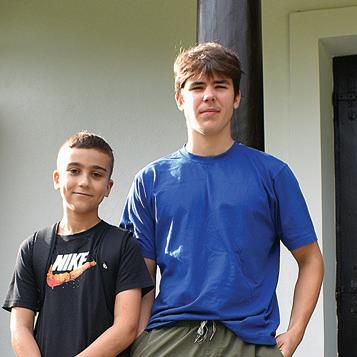
this was an opportunity to form deeper bonds and more meaningful connections. And in that regard, Chris had a leg up on the other volunteers: the child of Polish immigrants, Chris speaks Polish fluently.
“We remain very connected with our Polish heritage in our home—we speak it, we have Polish meals most nights,” Chris says. “It is one of the reasons I felt compelled to choose a service program in Poland, where I could connect with my family’s history and culture while really making a difference in the local community. The kids were very comfortable with me because we could communicate in both English and Polish, which I think made the experience more impactful for me and for them.”
And while Chris’s academic interests lie in the sciences—specifically in the area of quantum physics—his time in Poland has opened new pathways for him.
“I feel more confident in my abilities to lead a group of people—young people especially,” Chris says. “I also feel like teach ing may be a future career for me. I hope to return to Reymontówka again next year to continue working with the campers while continuing to develop my skills as a teacher.”
28 Taft Bulletin / FALL 2022
Global Connections
Fiona Zimon ’24
AS ONE OF THE STUDENT-LEADERS of Taft’s Interact Club, Fiona Zimon ’24 is deeply committed to inspiring young lead ers to become informed and responsible global citizens through service. Over the summer, Fiona took that commitment to a new level, traveling across the globe to engage in a range of service projects while fully immersing herself in the cus toms and traditions of Oceanic cultures.
Fiona spent three weeks in locations across Fiji and Australia, engaging in service work that ranged from conservation and eco-restoration to harvesting vegetables and preparing food for families served by a local shelter. The nature of each day’s work was driven by the needs of the community.
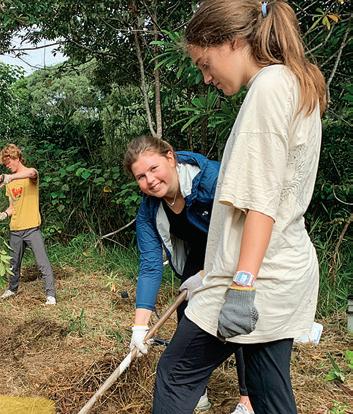
“In 2014, invasive ants from Asia spread across northeastern Australia, destroying trees and impacting the entire ecosystem in the region,” Fiona explains. “A species of frog that used the trees to hide from predators became endangered. We partnered with a local conservation group to plant new trees; reintroducing the native trees to the rainforest has helped increase the endangered frog population. We also vol unteered at a wildlife refuge where we saw native Australian animals such as koalas, kangaroos, alligators, and cassowaries.”
Much of the work Fiona did in Australia was focused on conservation and the envi ronment. And while she also did beach cleanup and learned to propagate coral on Fiji’s Leleuvia Island, it was learning about the Fijian people and their culture that not only shaped her time there, but delivered the most profound experiences.
“Our guides also taught us some Fijian,” says Fiona. “The most important word in the language is bula, which translates to a very enthusiastic ‘hello.’ They explained that everyone exchanges this greeting, regard less of the circumstance or relationships. In Fiji, it is an unwritten rule that you must
greet anyone and everyone you cross paths with. I liked that a lot, as it is so different than what we do in the States. Throughout the rest of our time in Fiji, we would greet everyone we encountered in that way.”
One of the most influential Fijians Fiona encountered was a woman named Shahini.

“We spent a day learning how to cook traditional Indo-Fijian food with Shahini. We made chai tea, seasoned fried fish, rice, eggs and tomato, and okra. It was deli cious,” Fiona recalls. “Shahini taught us the importance of food in Fijian culture. Meals bring people together. Often, entire villages will come together and eat and enjoy one another’s company. Meals are an event, a festivity that is celebrated.”
For Fiona, preparing food in Fiji went beyond celebration.
“We spent the afternoon preparing dishes for a local women’s shelter. We then served the families their meal and played with the children there. The shelter provides safe housing for women in need. Some women had escaped abuse, some
were widowed, and others were single par ents. Many struggled to feed their large families. Knowing that providing this meal made such a big difference was very spe cial. Supporting these strong women was very moving. I am now looking for ways to continue supporting this shelter.”
Fiona’s time in Oceania included some traditional tourist activities, as well, from a private tour of the Sydney Opera House to learning to scuba dive on the Great Barrier Reef. But in the end, it was the people she met who truly left their mark.
“I am so grateful for this experience and all the people I met on the trip. While the highlight for me was the many conversations I had with the residents of Fiji and Australia, I also noted in my journal that it was amaz ing to travel to Oceania with a group of kids from across the country who each had their own personal stories and culture. We shared our backgrounds with one another while immersed in the new cultures surround ing us. The world has so much to offer, and I look forward to discovering more of it.”
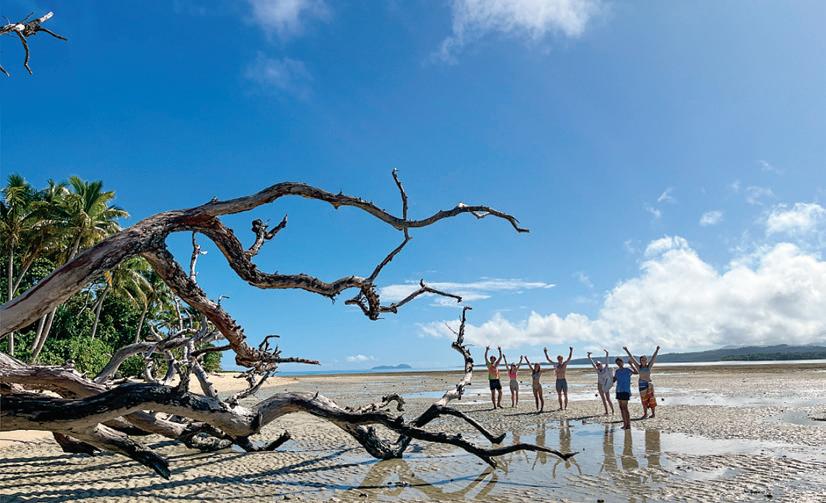
29 Taft Bulletin / FALL 2022
Bonds of Friendship
Ania Joszczyk ’23
WHEN ANIA JOSZCZYK ’23 was consid ering service travel programs, the goal of one particular experience caught her eye.
“When I went on the Global Volunteers website, I read that the main objective of the program in Cuba was to create bonds of friendship,” says Ania. “At a time when rela tions between the United States and Cuba are strained, building connections seemed important to me. I felt that any opportunity to engage in service work while creating relationships with the Cuban people would be really valuable, and that became my goal.”
Ania traveled to Havana last summer to build bonds and spread goodwill through service. Her travel cohort was comprised of a dozen people from across the United States. Most were retirees—her group included retired doctors, teachers, and an engineer. Ania and her brother, Chris ’25, were the only youth volunteers. While some people were assigned to painting and repairing buildings, working in a commu nity garden, and sewing and knitting items to be sold by a women’s crafts collective in support of women working toward eco nomic self-reliance, Ania and Chris worked
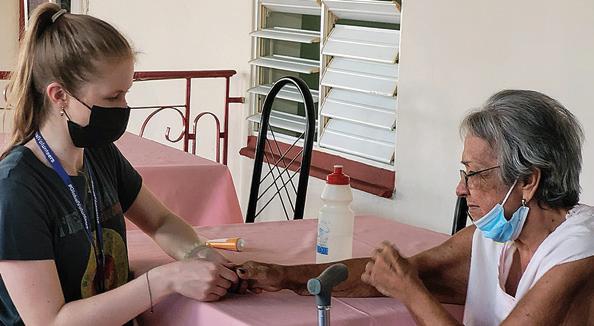
Ania’s work at the nursing home var ied from day to day. And while she did spend a day working in the kitchen sift ing rice, the majority of her time was spent with the elderly residents.
“Our team leader was a physician who specializes in eldercare, so she was a great resource in guiding us through our interactions,” says Ania. “She also led groups through stretching and physi cal exercises set to music. I helped guide the residents and encouraged them to participate in the movement activities.”
More meaningful, however, was Ania’s “hands-on” work.
“I gave a lot of hand massages. The residents don’t get a lot of visitors there, so physical touch and personal con nection really means a lot to them and really makes them feel cared for.”
After spending mornings with Cuba’s elders, Ania and Chris shifted their focus to its youth, and their desire to learn English, the language many see as the international language of opportunity. With input from the retired teachers in their volunteer cohort, Ania and Chris developed their own curriculum and led middle schoolaged children through lessons designed to improve their conversational English.
“Many of our lessons were built around games,” Ania explains. “What was really inter esting was that they all know English words and recognize them in writing. But they needed our encouragement and support to put the words all together and to speak them

aloud. The challenge was to first learn and then become comfortable with pronunciation. We would write sentences on a whiteboard and take them through them word by word, modeling the pronunciation along the way. One of the activities I came up with involved drawing a simple squiggle on a white board, then having students turn the squiggle into a more complete drawing. I would then have them use their English words to describe aloud what they had drawn. I think this was their favorite of all their activities.”
Each day also included opportunities to soak up Cuban culture by visiting mar kets, museums, and the artist José Fuster’s famed mosaic wonderland, Fusterlandia. In the end, however, it was the human moments—building the bonds of friend ship—that touched Ania most deeply.
“Working with the elderly in the nursing home is something I’d never done before. For the most part, the residents spoke very little English, and I spoke very little Spanish. We communicated with simple words and gestures. There was a moment when a woman was telling me about her life as an athlete. She didn’t realize that the limits of my Spanish prevented me from fully understanding that she was not just an athlete, she was an Olympian. A bilingual member of the nursing home team saw that I was missing that important piece of the communication and worked with us to bring us to that understanding. I was so amazed by her Olympic achievements, but also amazed by the power of working as a team to overcome communication barriers. That was a moment that truly stuck with me.”
 with nursing home residents each morn ing and schoolchildren each afternoon.
with nursing home residents each morn ing and schoolchildren each afternoon.
30 Taft Bulletin / FALL 2022 Around THE POND
Coastal Conservation
Noah Cinel ’24
AS A TEEN VOLUNTEER for Healing Meals, an NGO that prepares and deliv ers organic meals for individuals and families dealing with health crises, Noah Cinel ’24 understands the importance of service. As a student and champion of environmental issues, Noah was eager to put his understanding of service to work in a new arena, and on a broader scale.
“I knew that I wanted to do something involving ocean restoration, and so when I found the Rustic Pathways program I was immediately sold,” says Noah.
Noah spent 16 days with Rustic Pathways last summer working to protect the coastlines of the Dominican Republic.
Founded as a fishing village in 1874, Bayahíbe is a small town on the Caribbean coast of the Dominican Republic known for its sandy beaches, dive sites, and coral reefs. In the 1980s, the collective toll of white band disease, hurricanes, storms, the action of corallivores, thermal stress, and the increase in the level sea environment
and pollution led to a 97 percent reduc tion in several coral species. FUNDEMAR, the Dominican Foundation for Marine Studies, has been working to restore the reefs with the creation of nurseries for tissue growth and transplant. There are now more than 3,000 meters of coral grow ing in eight coral gardens. FUNDEMAR also tracks marine mammal data in the area, and conducts ongoing monitor ing of overall reef health and viability.
“Every day we would head out to sea in a tiny boat with scientists, educators, and other volunteers from FUNDEMAR to clear the ocean of trash, collect data on marine mammal sightings, and work on coral reef preservation” Noah explains.
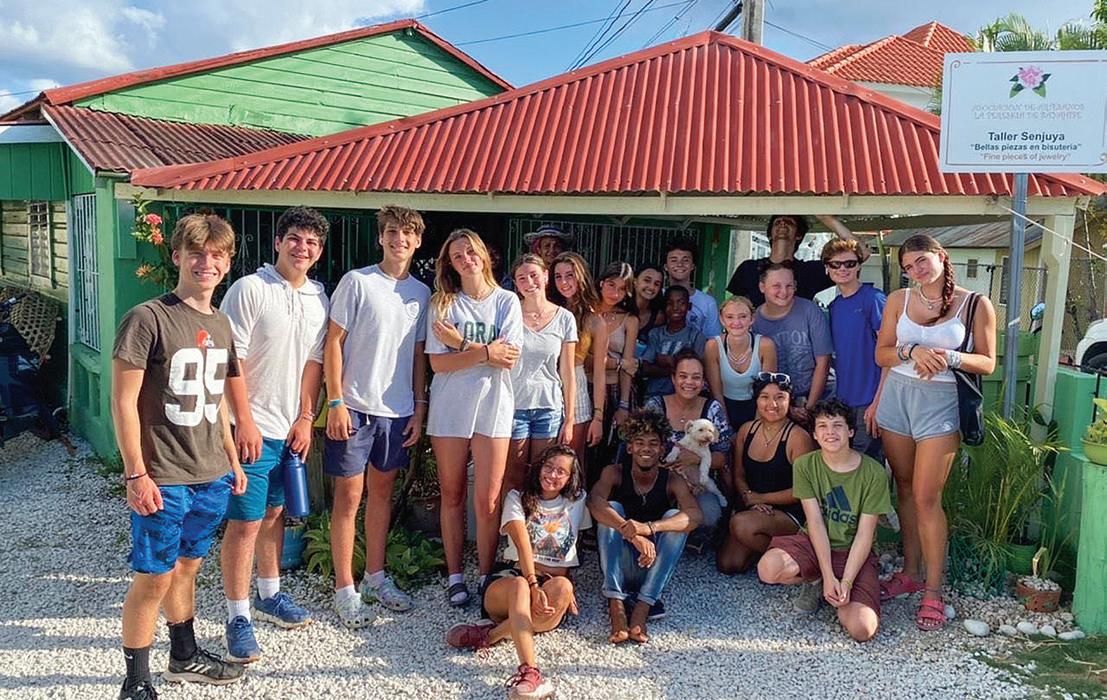
“It felt like we were really making a dif ference, which was very rewarding.”
To more effectively support the conser vation of marine ecosystems, Noah and his peers learned about threats to local marine and terrestrial life, scientific conserva tion methods, and the construction of reef
restoration structures. They spent time monitoring coral growth in a wet lab, and learned about rehabilitating mangroves.
“I’ve always had an interest in envi ronmental science, and so one goal of mine was to gain a better understand ing of how that field works. The broad scope of the program provided that.”
Perhaps the most rewarding moment of Noah’s travels came on Isla Saona, a small remote island off the southeast coast in the Dominican Republic’s La Altagracia province. It is a government-protected nature reserve, and a home to sea turtles.
“Our group woke up at 3 a.m. to hike along the beach, searching for turtle eggs and nests that might be in dangerous locations. We found a couple and brought them back to camp where they could hatch safely before being released back to the island,” Noah recalls. “That was a special moment that had a real impact.”
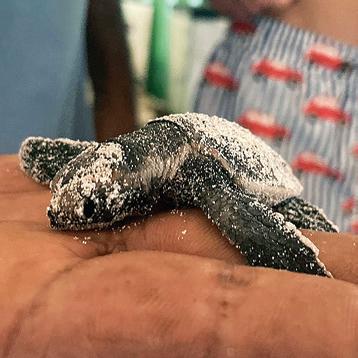
31 Taft Bulletin / FALL 2022
Safe Haven
Kaitlin Ip ’23
KAITLIN IP ’23 IS A RECOGNIZED leader on Taft’s campus. She is also a leader on the global stage, having served as a Young Ambassador and volunteer for the Changing Young Lives Foundation since she was in eighth grade.
“I have taught English lessons, vol unteered at school fairs and events, and traveled to rural parts of Mainland China in service to local children,” Kaitlin notes.

CYLF serves underprivileged children and marginalized youth in Hong Kong and the Mainland by offering no-cost center-based and outreach programs that support educa tion, identify and develop individual talent, and increase self-empowerment, all with the goal of maximizing opportunities for youth at school and work, and inspiring them to live their lives to the fullest. Over the summer, and with help from a Robert Keyes Poole ’50 Fellowship, Kaitlin helped CYLF advance its education initiatives in Hong Kong.
“I was working in the Hong Kong branch of CYLF, around 45 minutes away
from the city. I traveled to the CYLF cen ter three to four times a week to teach English to kindergarten and primary school-age students,” Kaitlin says. “Because the students only speak Cantonese in their homes, there is very little oppor tunity for them to speak or practice English during the summer months.”
Kaitlin led classes ranging in size from 10 to 30 students for a few hours each day. Formal class time focused on gram mar, structure, and vocabulary, and was followed by periods of play and casual interaction during which their new lan guage skills could be put to work.
“The main goal was to make them feel more comfortable understanding and speaking English,” Kaitlin says. “But
throughout my four weeks at the center, I also taught the students about different cultures and countries across the world.”
Each evening, Kaitlin prepared plans and supporting materials for the next day’s lessons, which she presented to center leadership for approval before starting her workday. And while CYLF provided a list of topics for Kaitlin to consider, she was afforded full cre ative control over the lessons.
“I usually started with a warmup activ ity to engage the body with the mind and to release any energy and tension. Then I would begin my presentation, show ing students pictures and videos of new material, and asking questions about their personal experiences,” says Kaitlin. “Finally, the students would take a quiz on the information covered that day.”
It was in the less structured moments that the children shared more about their personal lives with Kaitlin, allow ing students and teacher to establish a deep mutual trust and bond.
“It was more than school, it was a safe haven where I could connect with chil dren and better understand what their lives were like outside of the classroom,” says Kaitlin. “These children, seemingly innocent and ignorant of the harsh reali ties of life, have been through much more than I ever have. Their resilience, humil ity, and optimism is truly inspiring, and something I continue to carry with me.”
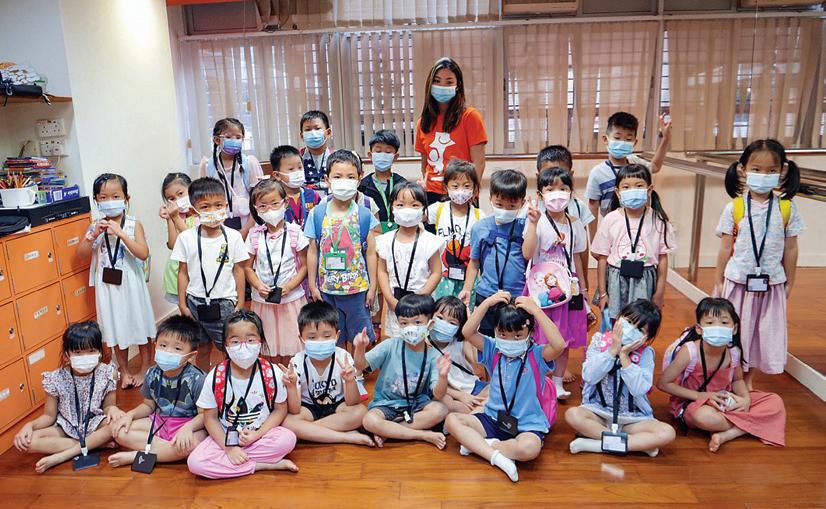
32 Taft Bulletin / FALL 2022 Around THE POND
Meg Page ’74 Fellowship Travelers
To honor her commitment to compassionate health care, the Meg Page ’74 Fellowship is awarded annually to students who wish to explore an experience or course of study devoted to the provision of better health care in areas such as public health, family planning, medical research, mental health, and non-Western practices of healing.
Cultural Connections
Khai Shulman ’23
MORE THAN 125 YEARS AGO, Horace Dutton Taft wrote, “A great advantage of boarding school is that it gives opportunities for students to get out of themselves. They must work for others.” It is an understanding that lies at the heart of the Taft School motto—Not to be served but to serve—and one that Khai Shulman ’23 has fully embraced.
“Service work is something I try to incorporate into my life on a regular basis,” says Khai. “Through the service work, I am able to gain real experience and broaden my outlook and view of the world, which is not something that can be done through a textbook. It also allows me to introspectively examine my own biases and work towards a leadership mindset.”
Over the summer, Khai traveled to Vietnam’s Hue province, where he spent three weeks in the township of Thuy Bang working with children in the Duc Son Orphanage. Founded by Buddhist nuns 35 years ago, Duc Son is now home to nearly 200 children who range in age from new born to 18. Through a family friend, Khai learned that the nuns were eager to welcome older, school-aged volunteers, particularly those who identified as male. For Khai, the opportunity seemed like a perfect fit.
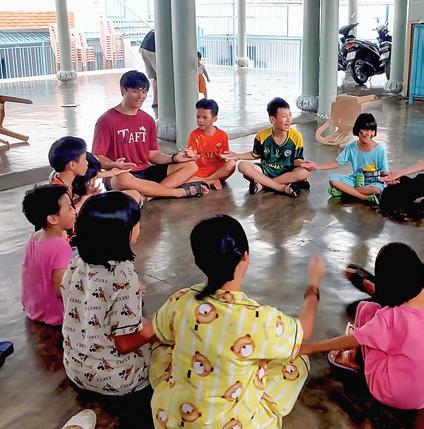
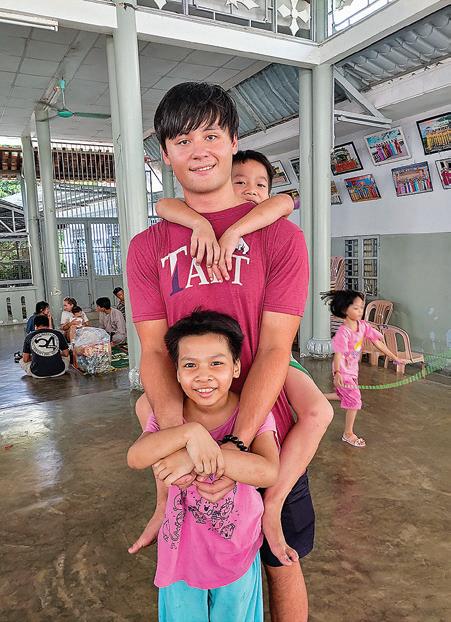
“I wanted to share insights of American culture and expose the kids to mul tiple perspectives while increasing my
own understanding of my multicultural upbringing,” notes Khai, whose mother is a Vietnamese-American refugee. “Overall, I hoped to serve as a positive role model for both the boys and girls, and build a lasting relationship with the orphanage.”
Working with groups as small as 10 and as large as 40, Khai prepared daily English language lessons for the children, taught them Western games, and offered swimming lessons.
“I would create structured English les sons for the kids; in return, they would teach me words and phrases in Vietnamese. After a period of studying each morn ing, we would transition over to indoor games, where we both practiced new-found language skills,” says Khai. “The nuns
explained to me that it was essen tial for the children to take a long midday rest. While they rested, I would explore the city of Hue, the ancient capital of Vietnam, and pick up materials that the orphanage lacked. The afternoons were filled with additional English lessons, field sports, and swimming lessons. In all of our activities, I encour aged the children to be confident and curious, and to take on leadership roles.
“The experience made me realize that there are so many future leaders in the world who just need the platform and resources to become successful. I plan to stay in touch with the orphanage via Zoom and to possibly create an annual Taft trip to volunteer at the Duc Son Orphanage. The work at Duc Son would benefit both Taft students and the orphans by exposing both groups to new ideas and perspectives while embracing Taft’s motto. The trip is life-altering, as one is exposed to nonWestern philosophies of thought (working in a Buddhist orphanage in Vietnam), while working with remarkable children.”
33 Taft Bulletin / FALL 2022 Around THE POND
From Junior Doctor to Surgical Skills Intern
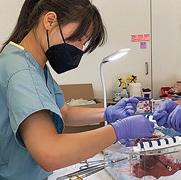
Fiona Chou ’25
AS A MIDDLE SCHOOL student, Fiona Chou ’25 worked to build a community of “junior doc tors” by creating a science-based, research-driven YouTube channel. Inspired by a middle school teacher with a passion not just for science, but for making science accessible, Fiona spent hours poring over medical journals, scientific publications, and websites to develop content for her channel. She relied heavily on information published by medical vanguards, including the Mayo Clinic and Johns Hopkins University.
“I wanted to create a platform for people who had the same interests as me,” says Fiona, who, in her middle school videos wears a white lab coat while using both physical and digital models to walk her viewers through lessons on the anatomy of the heart, disorders of the central nervous system, the health benefits of chocolate, and SARS-CoV-2, to name just a few.
Over the summer, Fiona traded her lab coat for scrubs and became part of a new and larger community of people who share her interests—and her passion—for science and medicine. Through a cardio thoracic surgical skills internship at UCLA School of Medicine, Fiona networked with premed students, medical interns, med school professors, and practicing surgeons.
Sponsored by the American Academy of Medicine and Surgery, the two-week internship program is a highly competitive and interactive classroom, laboratory, and lecture intensive that leads participants through the first steps toward mastering fundamental cardiothoracic surgical skills and more complex cardiothoracic surgeries.
Using porcine hearts in a wet lab, Fiona performed a range of surgical procedures, from aortic valve replacements and coro nary artery bypass grafts to cardiothoracic dissections and aortic vessel ligations.
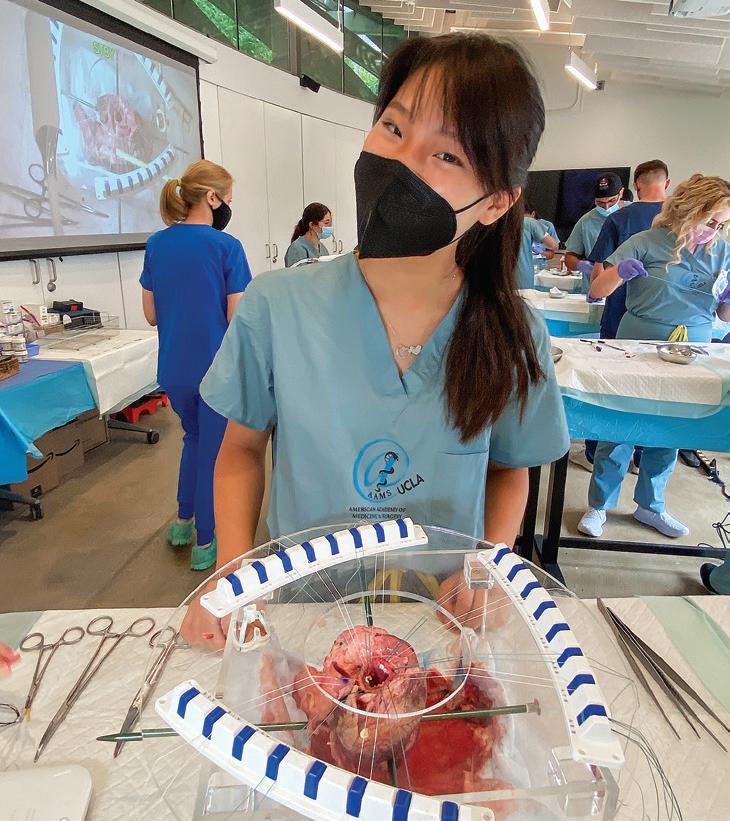
Fiona prepped for each day’s practicum by tapping into the scientific research skills she honed as a passionate science student and digital content creator. At 6 a.m. each day, she began preparing for the 8 a.m. lab by researching and study ing the day’s scheduled surgical procedure. Her preparation might also include tying and retying surgical knots or testing her self on anatomy through blind drawings.
“You really have to learn the anat omy of the heart to perform those procedures successfully, and properly tied knots are so critical to all surgical procedures,” Fiona explains. “It is really important to have both things down.”
The instructors were practicing physicians who lent not only their medi cal expertise to the program, but also their insights and experiences into
what it takes to become a surgeon.
“Our teacher is an attending surgeon at UCLA School of Medicine, and continu ally tied what we were learning to his own experiences in the OR,” Fiona recalls. “He talked about a range of experiences that even went back to his days as a surgical resident, and how those experiences made him the doctor he is today. We also had afternoon sessions with medical students and attending surgeons from UCLA and other universities who gave us a very broad view of their dayto-day lives, including some of the challenges they faced along the way. Understanding their journeys was very meaningful for me, as it gave me a preview of what my future might look like. I am certain now that medi cal school is definitely the path for me.”
See what a day in Fiona’s life as a surgical intern was like by scanning the QR code here or visiting her YouTube channel: https://www.youtube.com/ watch?v=fdBWpAEClRE
34 Taft Bulletin / FALL 2022 Around THE POND
Giving Voice, Sharing Love
Jack Johnson ’23
JACK JOHNSON ’23 has fond memories of his elementary school years. He also has memories that he’d prefer not to recall.
“There were students in my school who were bullied and made to feel unwelcome. Many of them had learning and other dif ferences. I had no clue how to help them back then,” says Jack. “Now, all these years later, when I found an opportunity to help children feel heard and loved in an under staffed hospital, I jumped at the chance.”
Jack spent one month in Ho Chi Minh City, Vietnam, over the summer working with children with cerebral palsy, autism, and Down syndrome.

“I primarily worked with children who ranged in age from 3 to 8 years old. I also did some rehabilitation work with two adult women,” Jack notes. “All of the work was done in a hospital setting under the guidance of hospital staff, and included speech therapy and physical therapy.”
As physical therapy often involves the repetition and progression of therapeutic movement, the hospital’s physiotherapists taught Jack appropriate “routines” to employ with each patient.
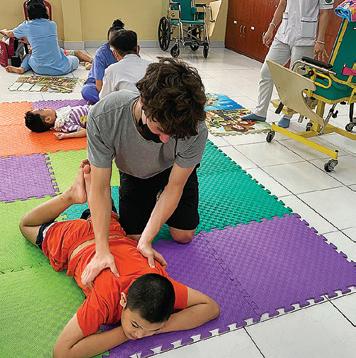
“The speech therapy involved routine and repetition as well,” Jack says. “We found that songs and music were very effective ways for the children to learn and articulate words and sounds. We would sing along with them. By the end of my time there, I could see that they had really learned to vocalize many of the lyrics.”
The work was challenging at times, often due to the language barrier, and also quite rewarding. But it was the rela tionships Jack built along the way that helped define his time in Vietnam.
“The kids were always happy and excited to see me,” says Jack. “The doctors talked with me about their experiences
and what they wanted for their futures. Most impactful, though, was the connec tion I made with one of the nurses. She had just lost her 18-year-old son from complications of cerebral palsy. She was one of the most kind-hearted people I have ever met, and offered to take me places on her motorbike so that I could see the real Ho Chi Minh. I ended up meeting her family and many local restaurant owners. She introduced me to Vietnamese dishes
I probably would have never tried, and convinced me to leave the city and explore the more rural parts of Vietnam. This was one of the lasting friendships I made that I never imagined would be possible.”
35 Taft Bulletin / FALL 2022 Around THE POND
Hands-on Medicine
Erin Butler ’24
IT IS A RARE BUT EXTRAORDINARY thing when a high school student has the opportunity to explore a prospective career through hands-on work and intensive engagement. It is even rarer when that prospective career is medicine. With sup port from a Meg Page ’74 Fellowship, Erin Butler ’24 recently spent time with medi cal students at Brown University’s Warren Alpert Medical School in the classroom, the anatomy lab, and the exam room.
Erin’s passion for science and other STEM fields deepened during her mid year at Taft, ignited in part by Mr. Parente’s Honors Chemistry course. Parente’s enthu siasm for the subject matter, extensive knowledge, and exceptional classroom presence inspired Erin not only to continue studying chemistry, but to consider apply ing that knowledge to a career in medicine.

“I was looking for a program that would immerse me in the schedule and day-to-day life of a medical student, a position that seems amazing as well as quite daunting and intense,” Erin explains. “I chose this program because of its diversified and indepth experiences, ranging from cadaver dissections to medical ethics debates.”
The program is designed to give par ticipants a broad view of the fundamentals of medicine while connecting them more intimately with current medical students and their daily challenges, accountabilities, and routines. Erin and her peers began each day in the classroom studying anatomy and physiology, including the digestive, nervous, cardiovascular, and pulmonary systems. Their work then took them to the anatomy or cadaver lab, where they would observe (and often handle!) the human organs and structures they learned about in the class room. The day would often conclude in the clinical suites working with standardized
patients (trained medical actors), bringing the whole of the day’s learning together in a practical and applied setting.
“The most amazing part of the experi ence for me was working with cadavers,” Erin says. “We got to see and touch the inner workings of the digestive system, a brain with an attached spinal cord, bones and muscle tissue, and the chest cavity, including the heart and lungs. Many people do not have this opportunity until medical school, which makes it even more special and unique. After the hands-on portion, we had a discussion about the ethics of cadaver use in medicine. Brown hosts a special event for the families of people who have donated their bodies to the medical school at which the med students meet and express their gratitude to donor families.”
Conversations around medical ethics
were not limited to cadaver use: Erin and her peers also considered, among other things, the ethical implications of medi cal treatment plans and choices made daily by physicians, including the ramifications a doctor must consider in deciding if one patient might receive an organ transplant over another.
“I came away with new understandings about careers in medicine,” Erin says. “One of the most important things that I learned was that medicine does not follow the same path for everyone. The field is full of millions of different specialties and oppor tunities and everyone’s journey will look a little different. Building on this, health professionals never stop learning or inno vating. The frontier of medicine is pushed forward every day, and I am excited for all of the possibilities that are yet to come.”
36 Taft Bulletin / FALL 2022 Around THE POND
New York Botanical Garden
Summer Interns
FOR NEARLY 10 YEARS, Taft students have spent the summer months work ing with scientists in the Plant Research Laboratory and the William and Lynda Steere Herbarium at the New York Botanical Garden. It is part of a unique and meaningful partnership between the school and the Garden. Over the summer, Lilly Bunnell ’23 and Alex DiCorpo ’23 were the latest Tafties to engage in highlevel research with NYBG scientists.
Working with Dr. Robert Naczi, curator of North American Botany, Lilly studied a grass species proposed for protection under the U.S. Endangered Species Act. Because fundamental data and analysis
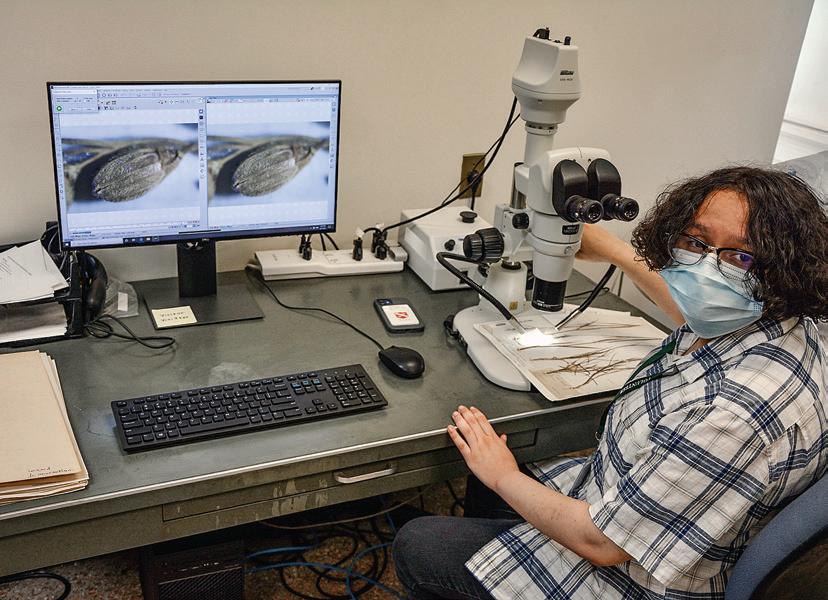
on its classification had been lacking, the protection process had been stalled. Lilly made great headway in providing data that will help move the process forward.
Alex was mentored by Dr. Matthew Pace, assistant curator of the William and Lynda Steere Herbarium, who is working to uncover new orchid species. Alex spent the summer extracting DNA from a wide range of plant specimens to aid in the quest.
“Once again, Taft students have done exceedingly well in their summer science internships at NYBG,” notes Dr. Naczi. “The internships have been tremen dously productive and transformational, for both students and mentors.” j
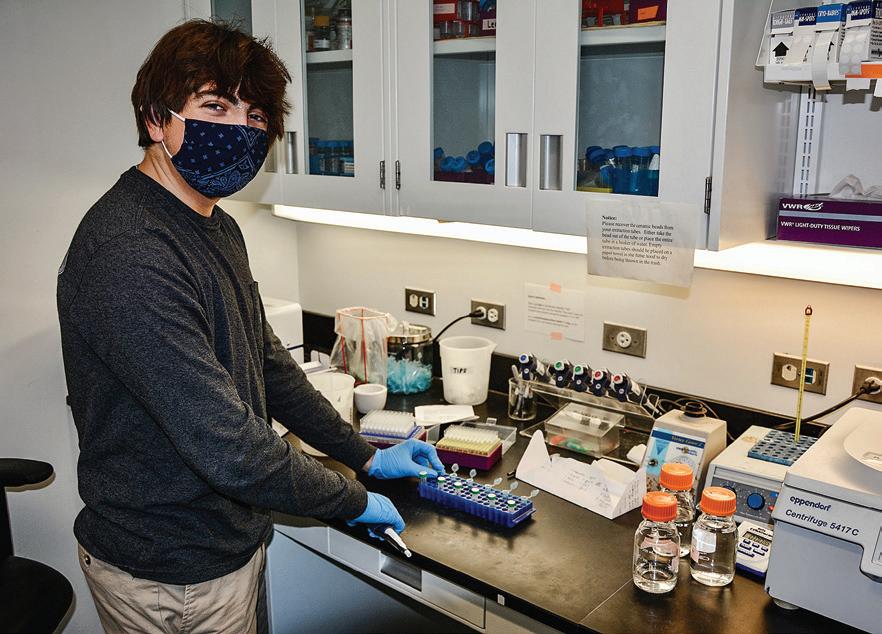 Above: Lilly Bunnell ’23
Left: Alex DiCorpo ’23
Above: Lilly Bunnell ’23
Left: Alex DiCorpo ’23
37 Taft Bulletin / FALL 2022 Around THE POND
Convocation 2022
When you show that you need help, that you have frailties, that you want the insights of others, that you seek collaboration, that, in fact, you are vulnerable, you make everyone feel trusted, and it comes right back to you. And that makes for strong culture.
To view the Convocation address video, use the QR code or visit vimeo.com/747976405.
 —Head of School William R. MacMullen ’78
—Head of School William R. MacMullen ’78
Poppy Jamie
Kicks Off the Morning Meeting Speaker Series
POPPY JAMIE, AUTHOR AND FOUNDER
of the multifaceted Happy Not Perfect brand, visited Taft in September for a Morning Meeting talk followed by a question-and-answer session.
Jamie began her career as a television and social media chat show host, where viewers began sharing their experiences with stress and anxiety. Using research into positive psychology, neuroscience, and meditation and with the help of developers, creatives, and guides, Jamie launched the Happy Not Perfect brand and app, offering tools, tips, and techniques to help improve mental well-being. In 2016, Jamie delivered a TEDx talk on the harmful effects of social media on mental health; she was part of Forbes magazine’s 30 under 30 list in 2017. Jamie was also appointed as the youngest board member of the Resnick Neuropsychiatric Hospital advisory board at UCLA to help consult on the well-being of students.
“Mental health is the most ‘in disguise’ challenge that we will all face because we’re all so good at pretending,” Jamie told the Taft community during Morning Meeting. “No one is born with good mental health; it is a practice, a skill that we all have to learn. It has to be a priority....When you look after it daily, you’ll put yourself in a position to achieve anything you want to in life.”

Jamie’s visit to Taft was made possible by The Charlie Fund and its educational partner, Mindset of Possibility. Launched in 2021, The Charlie Fund shares a legacy of kindness, love, and openness while honor ing Charlie Himmelrich ’17 by creating and growing spaces, programming, and resources

that help build connections and break down the stigma around mental health.
“Charlie was beloved on this campus by faculty and students, a source of incredible warmth, humor, loyalty, and love,” notes Head of School Willy MacMullen ’78. “He connected with everyone, and you could not spend a minute with him without feel ing uplifted. You just felt better when you were with him. And so, had someone asked, ‘How does a school become family?’ a lot of people would have said, ‘with Charlie.’ He had that deep and wide influence.”
Each member of the Taft commu nity received a copy of Jamie’s book, Happy Not Perfect: Upgrade Your Mind, Challenge Your Thoughts, and Free Yourself from Anxiety, prior to her visit. j
Above:
Top: Author Poppy Jamie
39 Taft Bulletin / FALL 2022
Charlie Himmelrich ’17 and his parents, Shelly and Billy Himmelrich ’82, in 2017.
New England Math League Competition

TAFT’S MATH TEAM, captained by Brian Chi ’23, was among the top finishers in the highly regarded New England Mathematics League 2021–22 competition. With just over 200 schools participating in the six-month long test of high-level applied math ematics knowledge and principles, Tafties earned the highest score in the region. Michael Ren ’24 led the team in scoring, placing second in the state and 19th in New England. The team got their first look at their hardware this week. Bravo, mathletes!

Super Sunday
IT IS A TIME-HONORED and beloved tradition that kicks off each school year with fun, connec tion, and teamwork: the Colors Dance followed by Super Sunday! Each student starts out as part of a single-color team. By the end of Super Sunday’s egg toss, tug-of-war, three-legged races, Crisco slide, and full-on paint shenanigans, the colors meld into one complete, connected, and blended school community, ready to face the new year together.

REDUCE, REUSE, RECYCLE is a philosophy that spans many aspects of community life at Taft, including the classroom. At the end of each year, Tafties are invited to donate gently used books to the Lending Library, where they are care fully sorted and inventoried. In September, students shopped titles online then picked up their books for use—free of charge— during the new school year.

Non ut Sibi 2.0
TAFT’S APPROACH TO COMMUNITY service will look a little different this year, affording every student greater opportu nity to make a difference for our service partners. Each season, every Taft student will engage in service work through their Afternoon Program activities. By con necting community service initiatives to our Afternoon Program, students and faculty alike learn more about our neighbors and the challenges they face in their daily lives. This perspective and understanding not only allows members of the Taft community to make an impact through their dedication to service, it allows them to reflect more deeply on the role of service in their lives. By offering Taft students ongoing and meaningful opportunities to engage in service, we believe they will become stronger and more deeply connected global citizens.
Members of the football team kicked off the year in September with a service trip to White Memorial Conservation Center—a 4,000-acre nature preserve and conservation cen ter—to engage in brush cleanup, trail maintenance, and other service work.
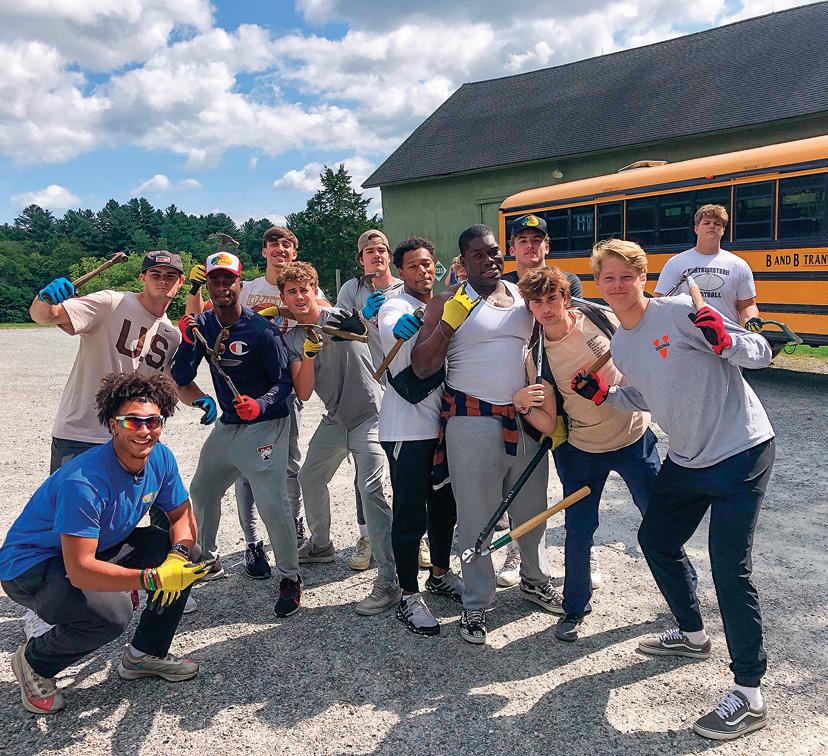
41 Taft Bulletin / FALL 2022
A New Day at Taft


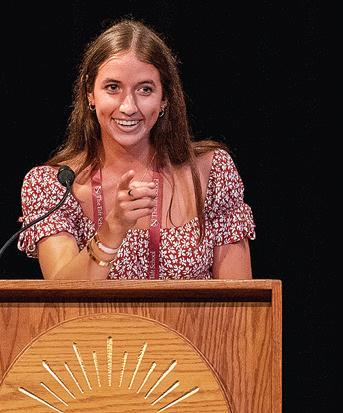


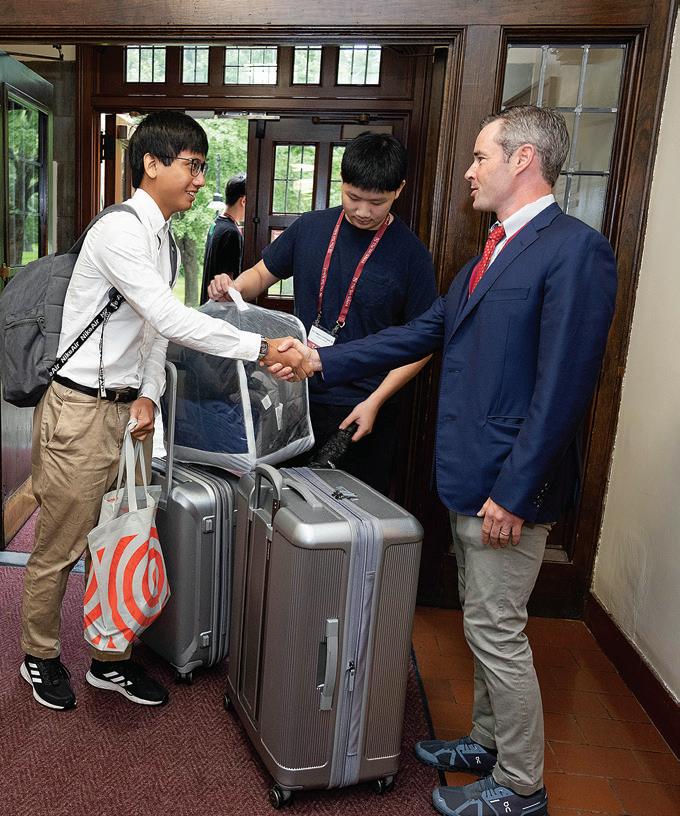
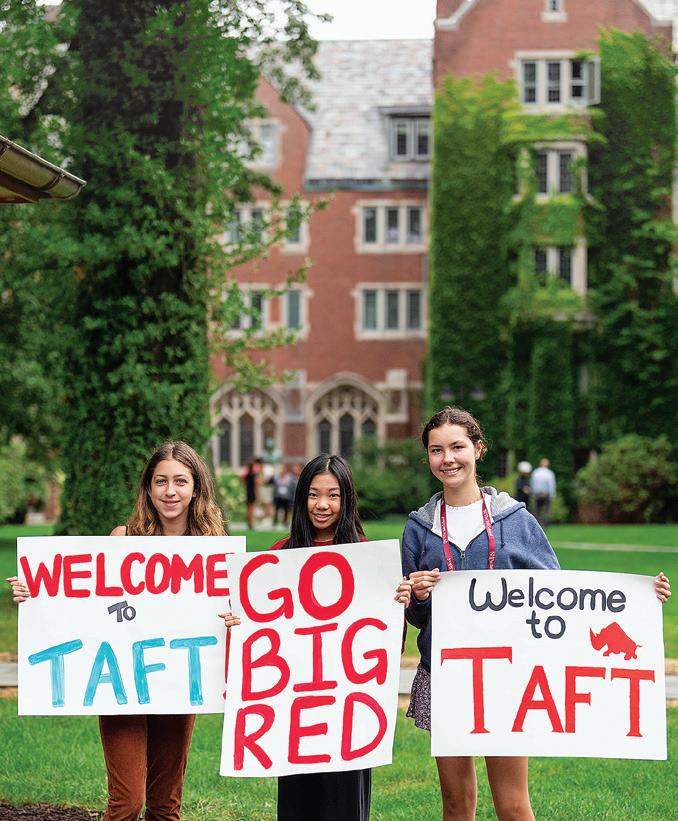
PRESEASON
2022–23
MOVE-IN DAYS,
ATHLETICS, WELCOME ADDRESSES, THE FIRST DAY OF CLASSES… IS THERE ANYTHING MORE EXCITING?

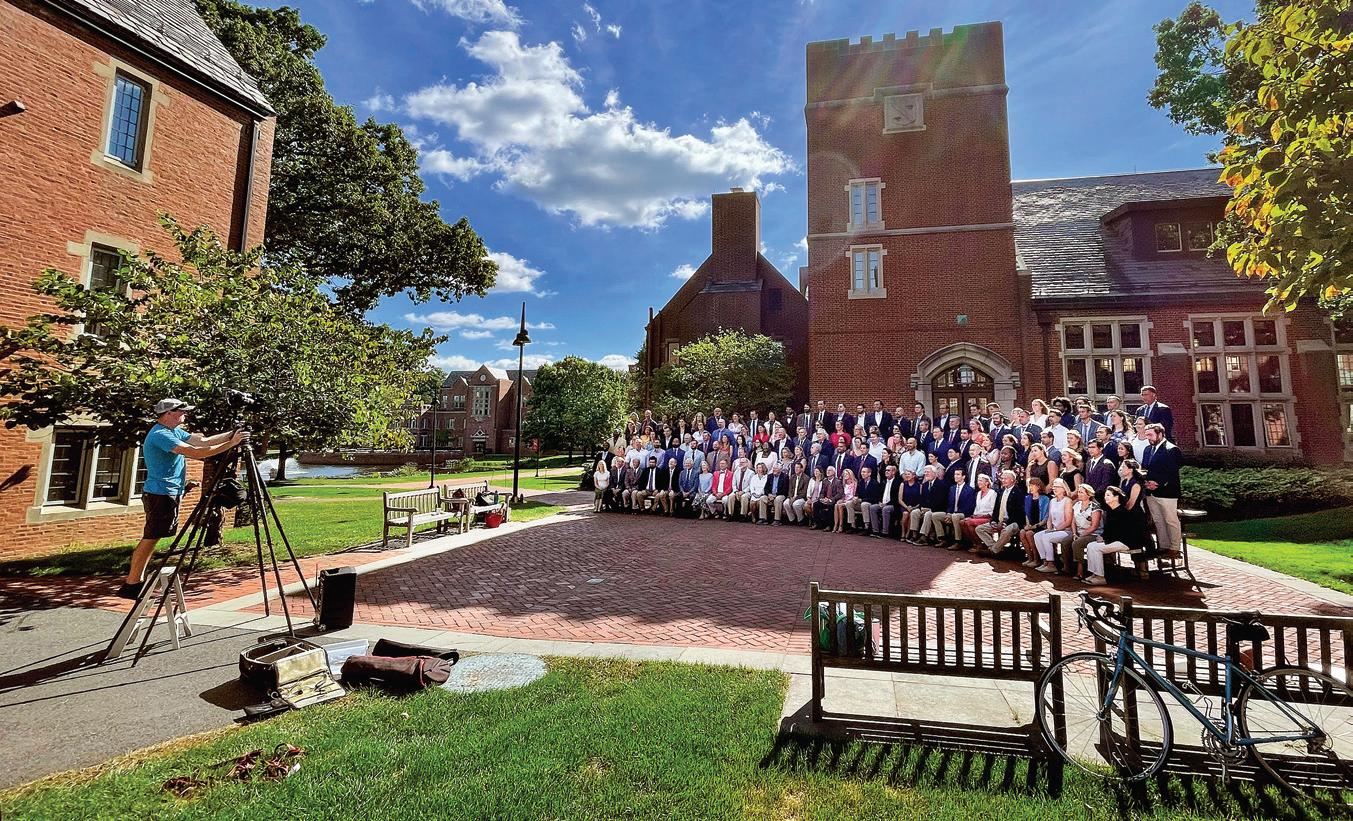

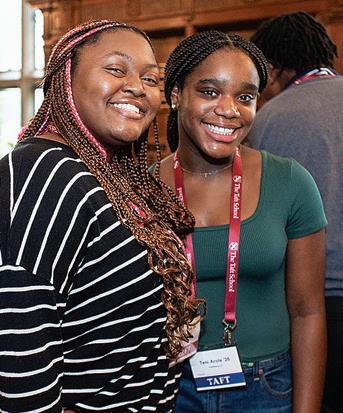
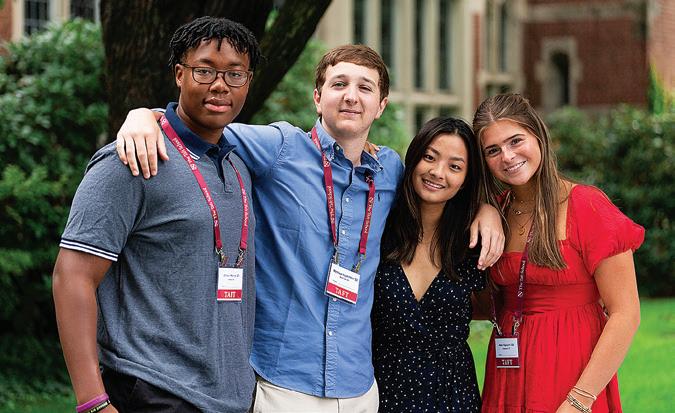
what’s happening?
Long before email blasts and Instagram posts, weekly events and activities were announced in flyers that were posted in a few key locations on campus through the 1970s and ’80s. This list of activities was typed up and posted after lunch on Mondays. It was used to announce and remind students of “any meeting, any trip, any event to which student participation is invited.”
1. The What’s Happening calendar from September 20–25, 1976. This edition announced class coffees, play tryouts, and club meetings. And students were urged to “Go show your support for the girls’ teams!! Cheer Fiercely!”
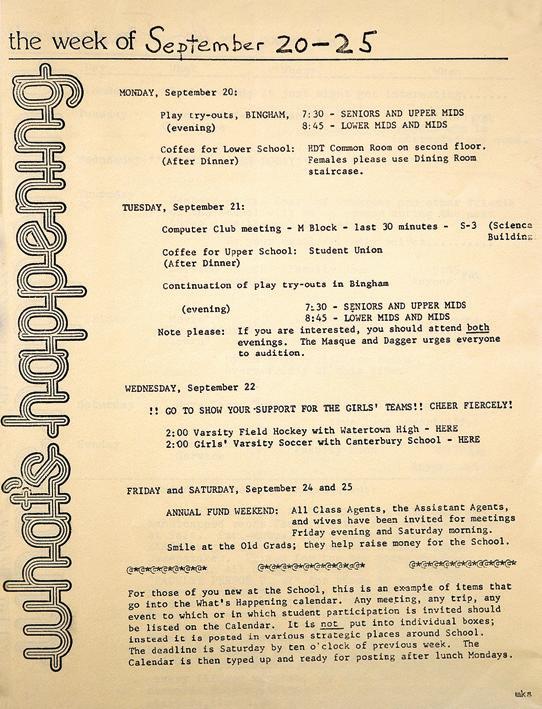
2. An after-dinner coffee for upper schoolers in 1976.
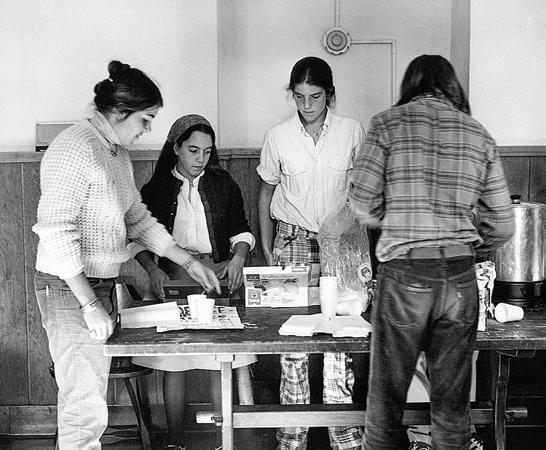
3. Support on the sidelines for the 1978 field hockey team.

3
—Beth Nolan Lovallo ’93 The Leslie D. Manning Archives
1
2 44 Taft Bulletin / FALL 2022
Looking BACKBACK
Let’s make this a BANNER YEAR!
Your annual giving makes a Taft education possible. Gifts of every size allow Taft to exceed the ordinary. Together, we can make this a banner year!
Please support the Taft Fund today at taftschool.org/give.
 Co-head Mons Bridget Brockelman and Matthew Vogelstein
Co-head Mons Bridget Brockelman and Matthew Vogelstein
The Taft School 110 Woodbury Road Watertown, CT 06795-2100 860-945-7777 taftschool.org/bulletin Change
Going With the Flow
Read about the rural water resources work Jennifer O’Hara Palmiotto ’82 is doing on page 14.
Island, watercolor, Jennifer Palmiotto.

NONPROFIT ORG U.S. POSTAGE PAID BURLINGTON VT PERMIT # 101
Service Requested
~ ~ ~
















 Left: Altisima Winery sits in one of California’s oldest wine regions, the Temecula Valley.
Tom Cramer ’83 at Altisima Winery, which he co-owns and opened in fall 2021.
An array of wines in Altisima's tasting room.
Left: Altisima Winery sits in one of California’s oldest wine regions, the Temecula Valley.
Tom Cramer ’83 at Altisima Winery, which he co-owns and opened in fall 2021.
An array of wines in Altisima's tasting room.











 HEAT
HEAT









 Right: Black rhino maquette by Sarah Richards.
Below: Feathers & Fur by Allen Hallett.
page bottom: Vantage by Michael Mawdsley.
Right: Black rhino maquette by Sarah Richards.
Below: Feathers & Fur by Allen Hallett.
page bottom: Vantage by Michael Mawdsley.







 Left: Mauck choosing a saltwater fly. ALEXANDRIA MAUCK
A carefully tied saltwater fly.
page top: A client with a False Albacore also called an “Albie.” VICTORIA KAMP
page middle: Mauck with a content client holding their catch, an “Albie.”
Left: Mauck choosing a saltwater fly. ALEXANDRIA MAUCK
A carefully tied saltwater fly.
page top: A client with a False Albacore also called an “Albie.” VICTORIA KAMP
page middle: Mauck with a content client holding their catch, an “Albie.”






 Chris Joszczyk ’25
Chris Joszczyk ’25






 with nursing home residents each morn ing and schoolchildren each afternoon.
with nursing home residents each morn ing and schoolchildren each afternoon.












 Above: Lilly Bunnell ’23
Left: Alex DiCorpo ’23
Above: Lilly Bunnell ’23
Left: Alex DiCorpo ’23
 —Head of School William R. MacMullen ’78
—Head of School William R. MacMullen ’78






















 Co-head Mons Bridget Brockelman and Matthew Vogelstein
Co-head Mons Bridget Brockelman and Matthew Vogelstein
